Summary
- In 2023, the Bitcoin wealth effect became apparent, with the price rising from $16,500 at the beginning of the year to $42,000. In addition to Bitcoin itself, market funds have also overflowed into its ecosystem.
- The most notable case is the explosion of the BRC20 sector under the Ordinals protocol. The BRC20 token market size has now exceeded $4 billion, compared to $100 million in March of this year, representing an increase of nearly 40 times, driving continuous innovation and development in the entire Bitcoin ecosystem.
- Currently, market attention on the Bitcoin ecosystem is focused on two aspects: asset issuance protocols, mainly covering Ordinals, Atomicals, Runes, PIPE, Taproots Assets, and scaling solutions, mainly covering Lightning Network, RSK, Stacks, RGB, BitVM.
- The main sectors with significant wealth effects in the current stage of the Bitcoin ecosystem are: BRC-20 assets under the Ordinals protocol, ARC-20 and Realm under the Atomicals protocol, PIPE under the PIPE protocol, and tokens in the Bitcoin scaling sector (RIF, STX), among others. This article analyzes the reasons for the wealth effect of these assets and introduces ways for investors to participate.
- In addition to technological innovation, the prosperity of the Bitcoin ecosystem depends on the participation of various market participants, including individual investors, exchanges, project parties, miners, and investment institutions. Therefore, this article analyzes the opportunities and risks for these 5 categories of groups in the development of the Bitcoin ecosystem, providing reference for investment and business expansion.
- Based on future macro environment and market conditions, the Bitcoin ecosystem has a promising development outlook. Not only popular currencies like BTC and ORDI will have significant appreciation potential, but there will also be new opportunities for hundredfold coins in the Bitcoin ecosystem.
- The Bitcoin NFT market trading volume has surged, but the current scale is relatively small, so it is expected to have a growth potential of over 100 times in the future. The Lightning Network is the biggest technological support in the medium to short term to help Bitcoin payments be adopted on a larger scale.
Combining the above analysis, Bitget Research Institute has made six major predictions for the future trend of the Bitcoin ecosystem.
Since the second half of 2023, not only has the Fed's interest rate hike cycle come to an end, but the approval of a Bitcoin spot ETF by the U.S. SEC has almost become a market expectation. Once the Bitcoin spot ETF is approved, it means that a massive amount of funds from traditional finance can flow into the Bitcoin ecosystem in a compliant manner. Under this huge expectation, not only is Bitcoin maintaining a good upward trend, but it is also driving the development of related projects in the Bitcoin ecosystem.
The most notable case is the resurgence of the BRC20 sector in the Bitcoin ecosystem since November, with significant wealth effects for BRC20 coins such as ORDI, SATS, and RATS, attracting extreme attention to the Bitcoin ecosystem. So what exactly is the Bitcoin ecosystem, and which projects are worth paying attention to? Understanding these may be the key to seizing the opportunity for wealth in the next bull market.
I. What is the Bitcoin Ecosystem
1. Definition of the Bitcoin Ecosystem
The Bitcoin ecosystem refers to a system composed of solutions, protocols, applications, and assets aimed at improving the utility and efficiency of the Bitcoin blockchain network. The current discussion on the Bitcoin ecosystem focuses on two aspects: asset issuance protocols and scaling solutions.
Asset issuance protocols: These are protocols that define the technical standards for issuing assets, including Ordinals, Atomicals, Runes, PIPE, and Taproot Assets.
Scaling solutions: These refer to solutions aimed at improving the basic performance of the Bitcoin network, with representative solutions including Lightning, RSK, Stacks, RGB, and BitVM.
2. How the Bitcoin Ecosystem Developed from 0 to 1
To understand how the Bitcoin ecosystem developed from 0 to 1, it is essential to consider several key development milestones of Bitcoin.
On October 31, 2008, Satoshi Nakamoto published a paper titled "Bitcoin: A Peer-to-Peer Electronic Cash System," detailing the concept and technical details of Bitcoin. Subsequently, on January 3, 2009, Satoshi Nakamoto mined the genesis block of the Bitcoin network, marking the birth of Bitcoin.
Since its inception, Bitcoin has attracted numerous individuals from the fields of cryptography and computer science. As Bitcoin continued to spread, the number of people accepting and building applications around Bitcoin increased, leading to the initial formation of an industry ecosystem consisting of chips, integrated circuits, exchanges, wallets, and application software for Bitcoin production and trading, bringing Bitcoin and various cryptocurrencies into the public eye.
In addition to Bitcoin production and trading, people also began to develop more applications that could be used in real life on the Bitcoin network, but encountered technical bottlenecks of the Bitcoin blockchain network itself. This is because blockchain technology faces the "impossible triangle" problem, making it difficult to simultaneously satisfy decentralization, security, and scalability in blockchain system design.
Compared to scalability, decentralization and security are generally considered more important characteristics. Therefore, without sacrificing the decentralization and security of the Bitcoin network, increasing scalability became a key exploration direction for Bitcoin technology breakthroughs.
To date, Bitcoin has undergone two major technical upgrades, which have laid the foundation for the prosperity of the Bitcoin ecosystem today.
The first major technical upgrade: Segregated Witness (SEGWIT)
Segregated Witness was an important technical upgrade to the Bitcoin protocol, increasing the Bitcoin block size limit from 1MB to 1MB+3MB and improving the extensibility (malleability) of the Bitcoin protocol.
The structure of Bitcoin transactions before the Segregated Witness upgrade was as follows:
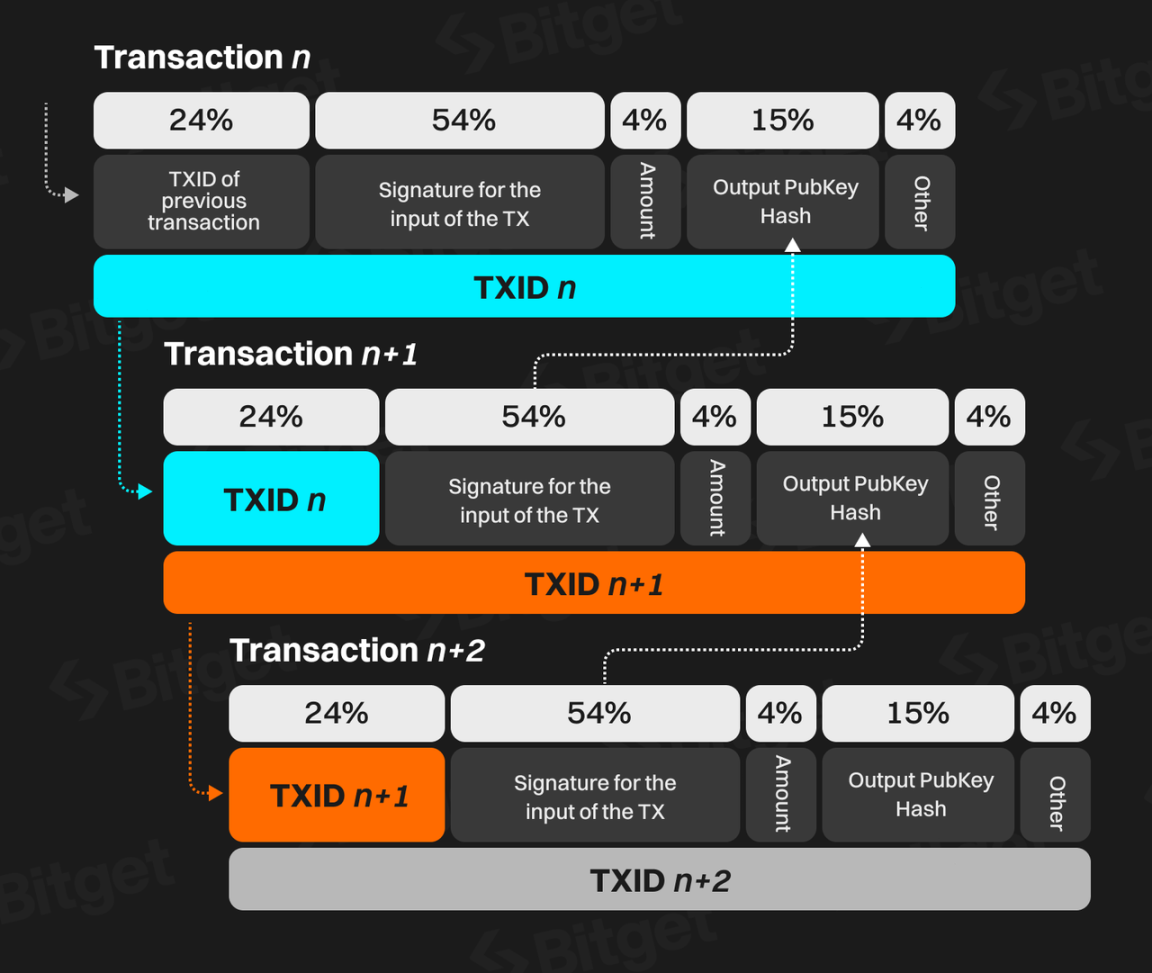
Structure of Bitcoin transactions before the Segregated Witness upgrade (Source: The SegWit Transaction Capacity Increase)
The structure of Bitcoin transactions after the Segregated Witness upgrade was as follows:
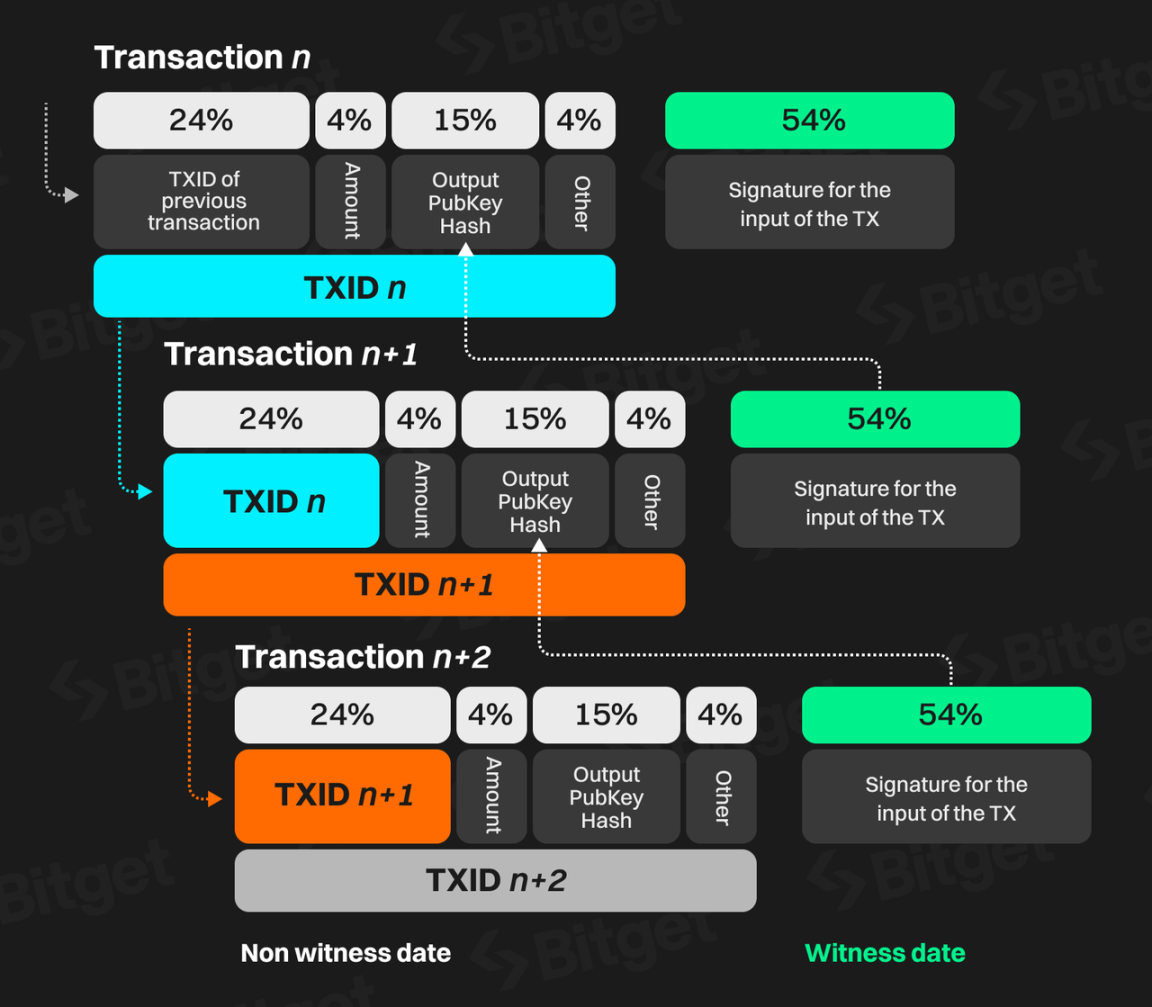
The second major technical upgrade: Taproot Upgrade
The Bitcoin Taproot upgrade mainly involves three Bitcoin Improvement Proposals (BIPs), which together constitute the core content of this upgrade.
1) BIP 340 - Schnorr Signature: This proposal introduces the specification of the Schnorr signature algorithm, which is used for digital signatures in Bitcoin. The Schnorr signature provides better efficiency, smaller signature size, and stronger security compared to the previous ECDSA signature. It also supports signature aggregation, which is particularly useful for multi-signature transactions, significantly reducing transaction size and improving privacy.
2) BIP 341 - Segregated Witness v1 (SegWit v1) and Taproot: This proposal describes how to improve the transaction structure of Bitcoin through Taproot and SegWit v1. It allows smart contracts to appear indistinguishable from regular transactions externally, increasing privacy. Additionally, it reduces transaction size, thereby lowering transaction fees. This BIP also includes detailed rules for using Schnorr signatures.
3) BIP 342 - Tapscript: This proposal updates Bitcoin's script language to be compatible with Schnorr signatures and Taproot. These changes make it more flexible and efficient to write and execute smart contracts on Bitcoin.
These three BIPs collectively bring significant improvements to the Bitcoin network, including higher efficiency, better privacy, and more flexible and powerful smart contract capabilities. These improvements are of great significance for the future development of the Bitcoin network, particularly in driving the construction of its ecosystem applications and decentralized finance.

After laying the foundation with two major technical upgrades, the development direction of the Bitcoin ecosystem has focused on two aspects: scaling solutions, continuing to explore new technological solutions with the goal of increasing Bitcoin's scalability, such as the Lightning Network, sidechain technology, and BitVM; and asset issuance protocols, seeking to issue more assets and deploy applications on the Bitcoin network, similar to Ethereum, such as the Ordinals protocol, Atomicals protocol, and Runes protocol.
In this trend, the first token ORDI based on the Ordinals protocol's BRC-20 standard, which appeared in March 2023, further opened the vigorous construction process of the Bitcoin ecosystem through a huge wealth effect.
3. Current Focus of the Bitcoin Ecosystem
Note: For easier expression and understanding, the following content will use "gas" to represent the transaction fee of the BTC network.
The Bitcoin ecosystem encompasses many aspects, but the current market's main focus is on two aspects: asset issuance protocols and scaling solutions.
3.1 Asset Issuance Protocols
In 2023, asset issuance protocols on Bitcoin have experienced explosive development. After several tokens in the BRC20 format under the Ordinals protocol had a significant wealth effect, more protocols have emerged in the market, mainly including: Ordinals, Atomicals, Taproot Assets, Runes, and PIPE.
3.1.1 Ordinals Protocol
What is the Ordinals Protocol?
The Ordinals protocol is an asset issuance protocol based on Bitcoin, launched by Bitcoin developer Casey Rodarmor in January 2023. The protocol consists of two parts: Ordinals ordinal theory and Inscription. The ordinal theory provides a method for assigning unique identifiers to 21 trillion Satoshis (the smallest unit of Bitcoin), while Inscription is the process of associating content with UTXO.
In simple terms, the asset issuance process of the Ordinals protocol is like writing content into a space (witness data), such as writing token information (recorded in JSON format) for BRC20, or writing image information for NFT into this space. The process of writing is called Inscription.
Why did the Ordinals Protocol emerge?
Because there has always been a lack of a simple and secure way to issue assets on the Bitcoin network. Casey, the author of the Ordinals protocol, used Inscription to carry content on UTXO, leveraging the security of the Bitcoin network and the scalability brought by Taprootscript, making it possible to issue assets simply and securely on the Bitcoin network.
Current Status of the Ordinals Protocol
Based on the Ordinals protocol itself, two main types of assets have emerged, including: BRC-20 tokens and Ordinals NFT.
- BRC-20 Tokens
BRC-20 is an experimental token standard for Bitcoin created by Twitter user @domodata on March 8, 2023. It enables the creation (Deploy), minting (Mint), and transfer (Transfer) of tokens through the use of JSON data in Ordinal inscriptions. These are the three main functions of the BRC-20 standard tokens.
As of December 4, 2023, the daily on-chain transaction volume of BRC-20 tokens is approximately around $22 million, while the daily transaction volume on centralized exchanges is currently between $800-900 million. The total market value of the BRC-20 sector fluctuates in the range of $3.5 billion to $4 billion.
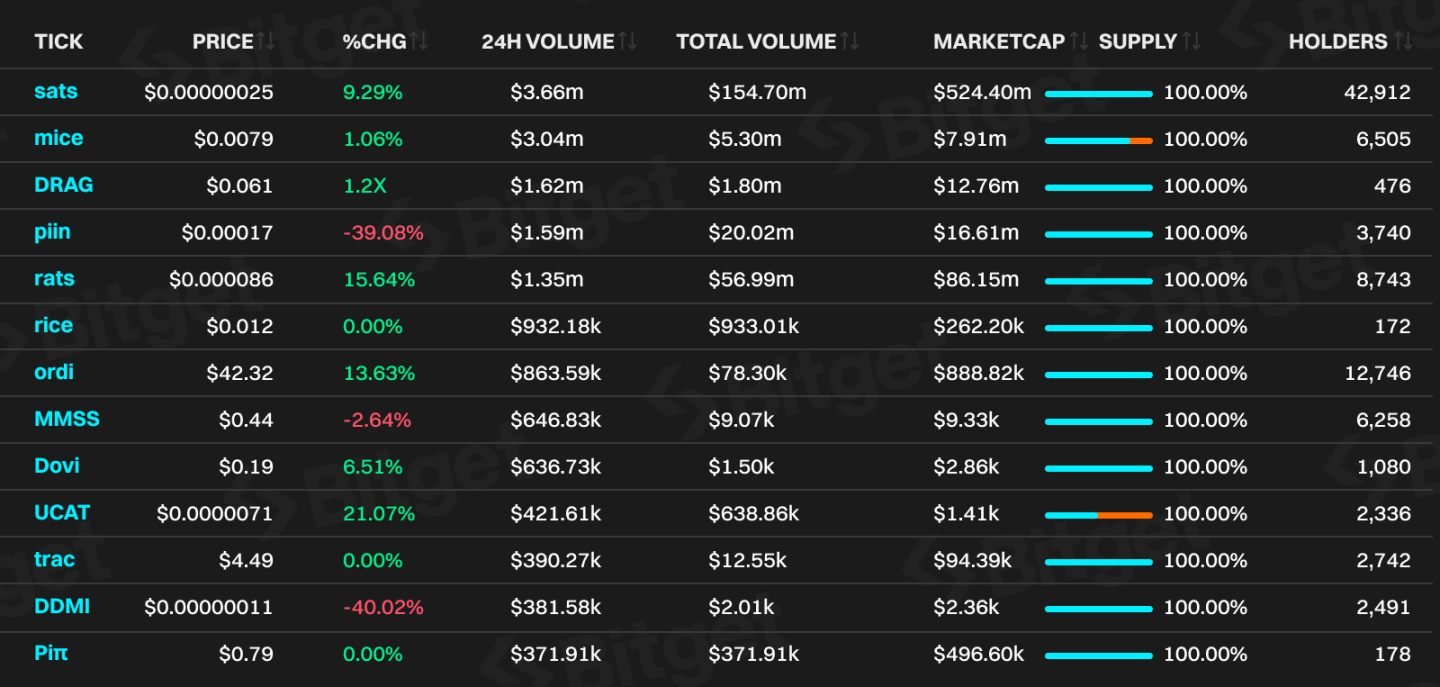
BRC-20 Token 24-hour Transaction Volume Ranking (Data Source: GENIIDATA, as of December 4, 2023)
- Ordinals NFT
Ordinals NFT is a digital asset based on the Bitcoin mainnet, using the Ordinals protocol. Unlike traditional NFTs, Ordinals NFTs are represented using Satoshis (the smallest unit of Bitcoin).
As of December 4, 2023, the recent 30-day trading volume of Bitcoin NFTs reached $371 million, almost on par with the recent 30-day NFT trading volume of $387 million on Ethereum.
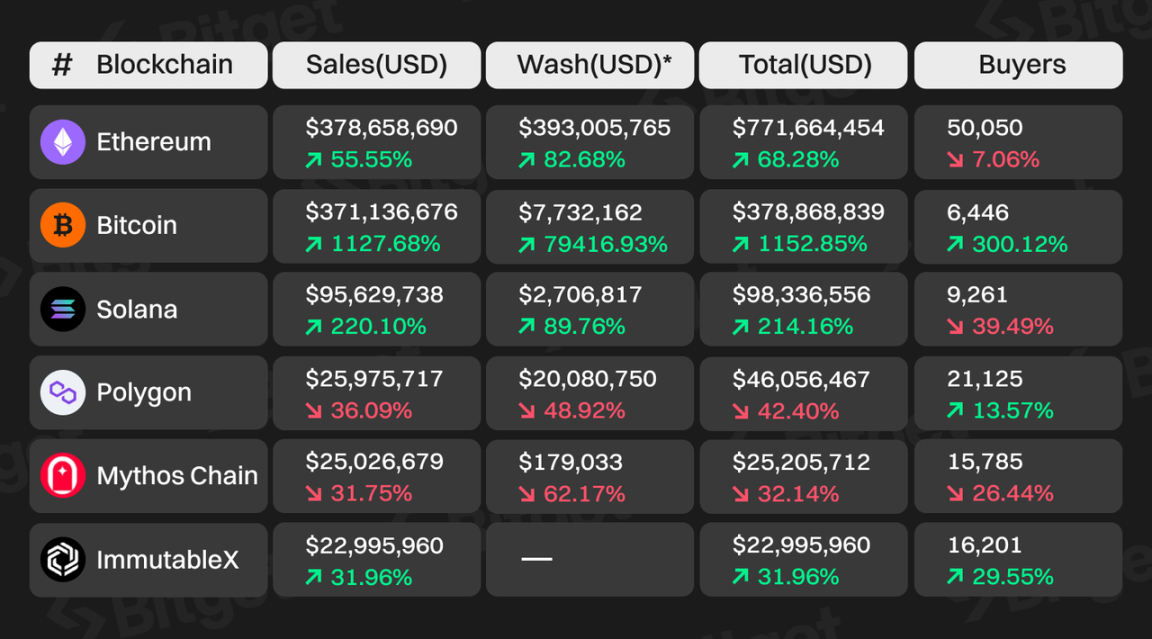
Data Source: CryptoSlam, as of December 4, 2023
Unique Advantages of the Ordinals Protocol
BRC-20 Tokens
Although the BRC-20 token standard is still in its early stages, it is gaining more attention as enthusiasts continue to explore it.
Strong Security: Because BRC-20 tokens are built on the highly secure Bitcoin protocol, it makes it difficult for hackers to infiltrate. Additionally, since BRC-20 "tokens" are essentially inscriptions and do not involve smart contracts, they do not have contract risks like ERC-20 format tokens.
Fair Issuance Mechanism: For a meme coin, a fair issuance method is crucial. Once created, all users with valid BTC wallets can participate in "minting" BRC-20 tokens. The issuance of BRC-20 tokens is relatively fair, and participation in minting requires paying gas, requiring users to pay real money to obtain corresponding token rights.
Ordinals BTC NFT
Based on the Ordinals protocol, BTC NFTs also have unique and tamper-proof characteristics, but there are some differences from a technical design perspective. From the current common practice of developers (with some exceptions), the differences between Bitcoin NFTs and Ethereum NFTs are as follows:
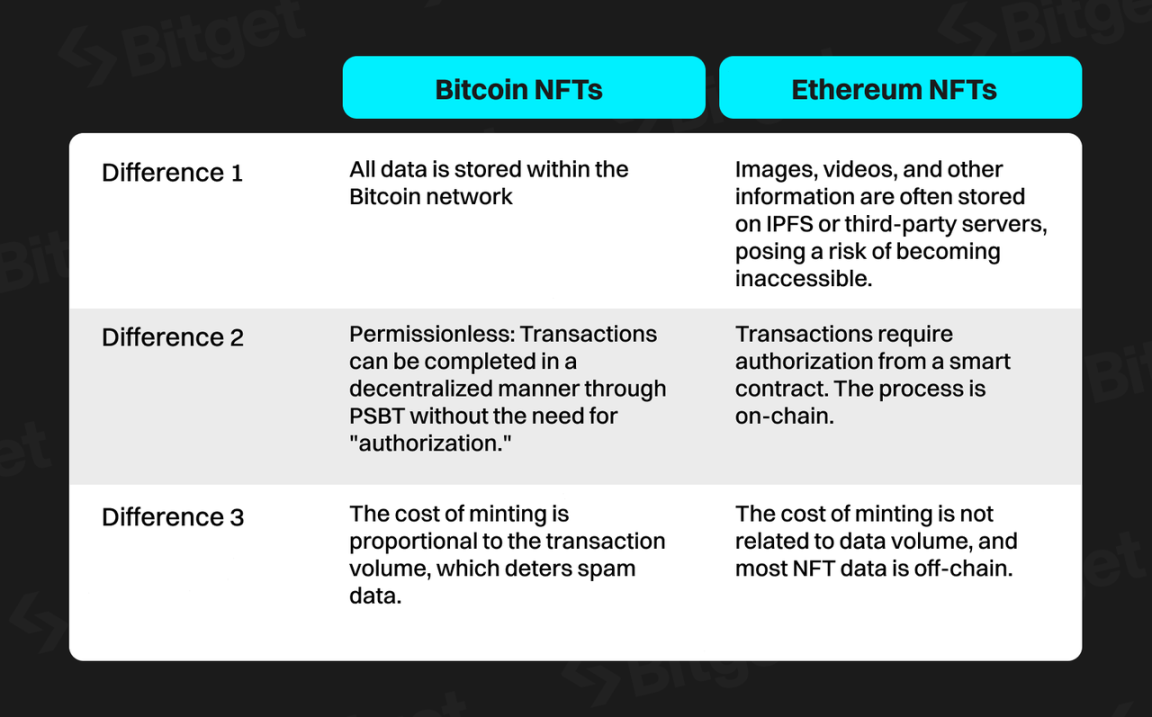
Overall, the Ordinals on Bitcoin represent a technological improvement for NFTs, providing a more complete and reliable form of digital art by directly storing all data on the Bitcoin blockchain to some extent.
Potential Issues with the Ordinals Protocol
While the introduction of the Ordinals protocol has brought new functionality and possibilities to the Bitcoin network, it has also brought a series of challenges and issues that need to be collectively addressed and resolved by the community, developers, and regulatory agencies. The core issues include:
Decreased efficiency in blockchain space usage: Ordinals works by embedding data in individual Bitcoin transactions, which may occupy a significant amount of block space. This can lead to miners needing to store a surge in the volume of Bitcoin network UTXO information, and it can also affect the network's processing speed and transaction costs.
High user learning curve: The Ordinals protocol increases the complexity of using the Bitcoin network. Ordinals maps BRC-20 and Ordinals NFT to specific "Satoshi," and to avoid affecting the asset meaning of these "Satoshi," users need to store these "Satoshi" in segregated wallets, increasing the difficulty for users to participate and the difficulty for project teams to develop wallet infrastructure.
3.1.2 Atomicals Protocol
What is the Atomicals Protocol?
The Atomicals protocol is an asset issuance protocol on UTXO (Unspent Transaction Output) type blockchains. The Atomicals protocol supports a variety of asset types, including: the ARC20 standard for fungible tokens, NFTs, Realms, and Collection Containers. On the fungible token asset side, the Atomicals protocol follows atomic definitions, using the smallest unit of Bitcoin, Satoshi, as the minimum unit for issuing assets. On the issuance side, the Atomicals protocol has both decentralized minting and direct minting methods.
Why did the Atomicals Protocol emerge?
The emergence of the Atomicals protocol is to build a more comprehensive asset issuance protocol compared to the Ordinals protocol. Unlike Ordinals, which relies on a third-party sorter to sort asset transactions, the Atomicals protocol ARC20 standard uses the smallest unit of Bitcoin, Satoshi, as the minimum unit for issuing assets, allowing Atomicals assets to trace complete transaction history without relying on any third-party sorter.
The Atomicals assets have two distribution methods: decentralized minting and direct minting. The decentralized minting method introduces a POW mode called Bitwork Mining, which requires CPU/GPU to calculate specific characters to complete minting, representing a fairer distribution method to some extent.
Current Status of the Atomicals Protocol
The Atomicals protocol includes the following four major asset types:
ARC20: Similar to BRC20 on Ordinals, it is a token format standard. The main projects include $ATOM, $PEPE, and $REALM.
NFT: The main projects include PUNK, XCSS (the first original collection), and Atommap (comparable to bitmap).
Realm: The concept of "Realm" proposed by Atomicals aims to disrupt traditional domain names and use domain names as prefixes.
Collection Containers: This is a data type for defining NFT collections, mainly used to store readable NFT collections and related metadata, similar to a type of on-chain data object storage.
Data Situation:
As of December 4, 2023, the total number of minting operations under the Atomicals protocol is 366,879, with a total expenditure of 55.8 BTC. The total number of minting operations under this protocol accounts for 2.69% of the total number of minting operations under Ordinals. The daily minting situation is as shown in the following chart:
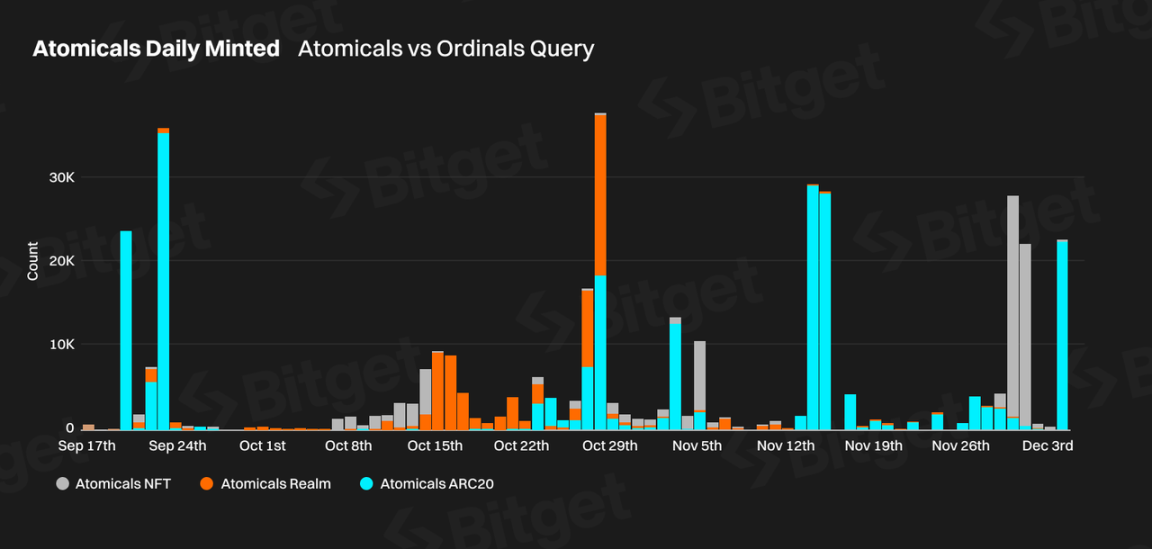
Quantities of Various Atomicals Assets (Data Source: Dune)
Compared to Ordinals, Atomicals is still in its early stages, with the peak minting volume per day being less than one-tenth of the peak minting volume of Ordinals.
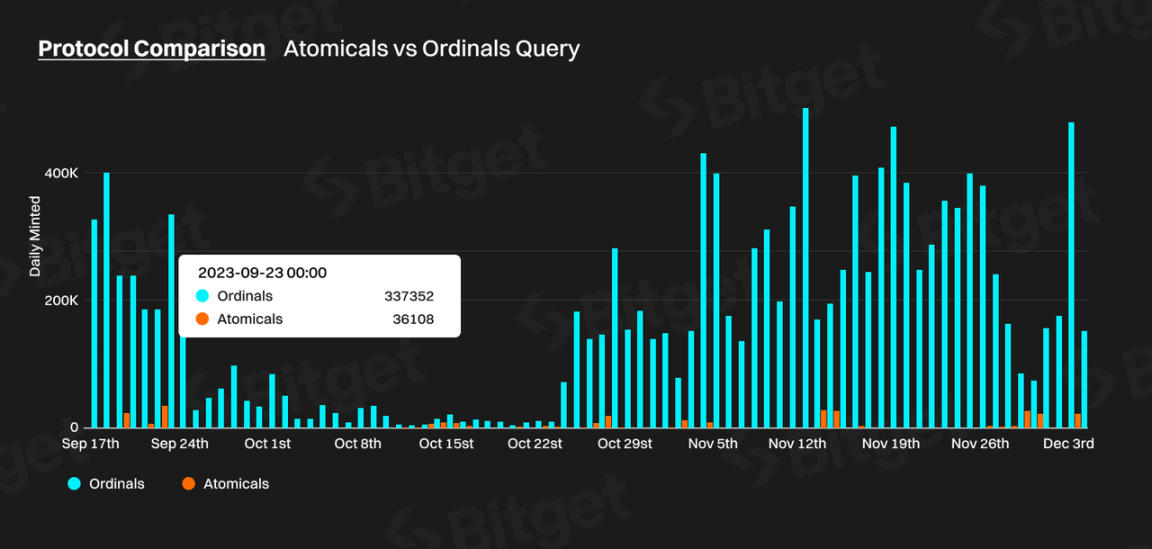
Comparison of Minting Quantities between Ordinals and Atomicals (Data Source: Dune)
Unique Advantages of the Atomicals Protocol
Reduced risk of errors: The Atomicals protocol has a "splat" operation, allowing users to selectively separate multiple Atomicals assets combined into the same UTXO, effectively avoiding the risk of assets being accidentally consumed as transaction fees.
Diverse asset distribution methods: The Atomicals protocol provides both decentralized minting and direct minting methods. The decentralized minting method requires CPU/GPU to calculate specific characters to complete minting, representing a fairer distribution method to some extent. The direct minting method is relatively centralized but can also address some special distribution scenarios.
Wide application potential: The Atomicals protocol allows users to represent assets on the Bitcoin blockchain in a more complex and diverse manner, surpassing the traditional simple payment function.
Potential Issues with the Atomicals Protocol
Technical complexity: The implementation of the Atomicals protocol may be relatively complex, requiring a deep understanding of Bitcoin scripts and blockchain technology, which may limit its popularity and application. Due to the complexity of operations and concepts, ordinary users may find it difficult to understand and accept the Atomicals protocol, which may limit its widespread application.
Slow current infrastructure development: Atomicals assets currently do not have a good trading market. The two main trading platforms have experienced multiple security incidents, and recently, Atomicals Market also experienced "zero-dollar purchases" due to technical vulnerabilities. Currently, most trading demand relies on C2C. There are only three public node services (Atomicals official, Atomical Market, nextdao), and occasional unstable node network connections may lead to trading requests not being sent out, resulting in the inability to mint or failed minting due to long waits.
The appearance of the Runes protocol is due to developer Casey's dissatisfaction with the creation of a large number of "garbage" UTXOs using the Ordinals protocol for BRC20. Therefore, a fungible token (Fungible Token) protocol based on the Bitcoin UTXO model was proposed. Unlike RGB and Taproot, which require off-chain data storage and retrieval infrastructure, or the problem of BRC-20 creating "garbage UTXOs" and occupying BTC space, the design concept proposed by the Runes Protocol can solve the user experience problem and not waste the space of the Bitcoin block.
Current Status of the Runes Protocol
The Runes Protocol is still a concept of Casey's and currently does not have a complete client and development tools.
Unique Advantages of the Runes Protocol
Based on the UTXO model: Closely integrated with Bitcoin's existing UTXO model, it enhances compatibility and natural integration with Bitcoin itself.
Simplified operations: The protocol uses a simple (ID, OUTPUT, AMOUNT) tuple mechanism, making token creation, transfer, and distribution intuitive and easy to understand.
User-friendly: The Runes Protocol is committed to simplifying the user experience, reducing reliance on complex operations, making it easier for users to understand and use.
Transparency and security: All operations are visible on the chain, providing higher transparency, and the burning mechanism of the runes also provides security for the protocol.
Potential Issues with the Runes Protocol
Symbol preemption issue: Lack of a mechanism to prevent symbol preemption may lead to early users occupying short and valuable symbols.
Inability to mint fairly: The Runes Protocol does not provide a fair minting function similar to the BRC-20 standard, so users cannot mint fairly.
Slow current development progress: The Runes Protocol is still a concept of Casey's and currently does not have a complete client and development tools.
PIPE Protocol
What is the PIPE Protocol?
The PIPE protocol is an asset issuance protocol developed by developer Benny, inspired by Casey's design of the Runes protocol and Domo's proposal of the BRC-20 standard based on Ordinals, integrating the advantages of both protocol standards. The PIPE protocol provides three main functions: deployment, minting, and transfer, abbreviated as DMT. These functions allow PIPE protocol assets to be created, distributed, and transferred within the Bitcoin network. In addition to fungible tokens, the PIPE protocol also provides a complete data structure and standard for non-fungible tokens.
Why did the PIPE Protocol emerge?
The emergence of the PIPE protocol stems from the shortcomings of asset issuance protocols in the current Bitcoin ecosystem. The PIPE protocol combines the respective advantages of the RUNES protocol and the BRC-20 standard, forming a new asset issuance solution.
Current Status of the PIPE Protocol
The PIPE protocol is designed by Benny to create a comprehensive BTC ecosystem (Trac System), as shown in the following figure. The protocol has lower complexity in asset issuance compared to BRC-20 and is more lightweight.
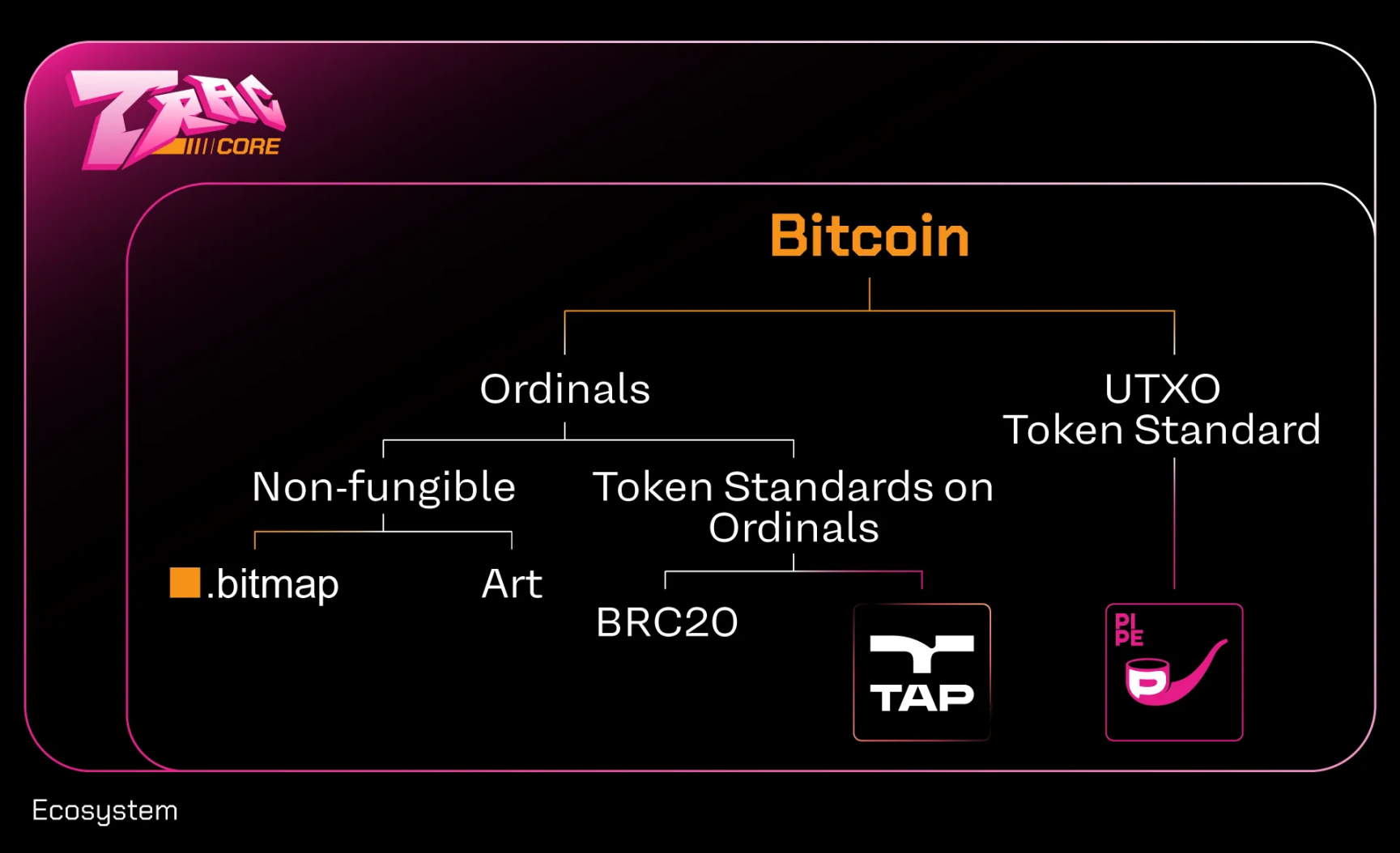
Ownership of the PIPE Protocol (Source: Trac Documentation)
Based on the PIPE protocol, there are now two types of projects deployed: FT (fungible tokens) and NFT (non-fungible tokens). As of November 16, 2023, a total of 16,976 tokens have been issued based on this protocol, and the leading FT $PIPE has seen hundreds of times increase.
Unique Advantages of the PIPE Protocol
Compatibility with the UTXO model: The PIPE protocol retains the tight integration with Bitcoin's UTXO (Unspent Transaction Output) model, ensuring compatibility with Bitcoin's native architecture.
Simplified operation process: Similar to the design of RUNES, the PIPE protocol adopts a simplified approach, making it easy for users to interact.
Fair minting mechanism: Similar to BRC-20, the PIPE protocol considers fairness in the token minting process, providing a fair minting mechanism.
Potential Issues with the PIPE Protocol
Technical complexity: Implementing the PIPE protocol requires adding additional complexity within Bitcoin's existing framework, which may make it more challenging for ordinary users and developers to understand and implement the protocol.
Taproot Assets Protocol
What is the Taproot Assets Protocol?
The Taproot Assets Protocol is a Taproot-native asset overlay layer built on the Bitcoin blockchain, mainly for asset issuance and transfer.
Why did the Taproot Assets Protocol emerge?
The Taproot Assets Protocol mainly addresses the effective and efficient issuance and transfer of arbitrary assets on the Bitcoin blockchain. This protocol specifically focuses on keeping these operations off-chain to avoid wasting blockchain block space.
Early attempts at Bitcoin asset protocols, such as Mastercoin and Counterparty, used the OP_RETURN opcode to directly represent assets on the Bitcoin main chain. This led to data inflation and efficiency issues on the Bitcoin public chain. Taproot Assets reduces the need for main chain space by representing and operating assets off-chain. Additionally, Taproot Assets improves asset programmability and privacy by introducing asset scripts that can be operated off-chain.
The Taproot Assets Protocol mainly relies on the following key technologies:
Merkle-Sum Sparse Merkle Trees (MS-SMTs): This data structure is used to effectively prove the existence, non-existence, and splitting and merging of assets. It supports proving the total amount of specific assets, ensuring that assets are not created or destroyed unnecessarily during transmission.
Taproot Asset Trees: This is a structure embedded in the Taproot script tree to carry assets. Each asset is represented by a series of MS-SMTs, with each asset ID corresponding to an MS-SMT.
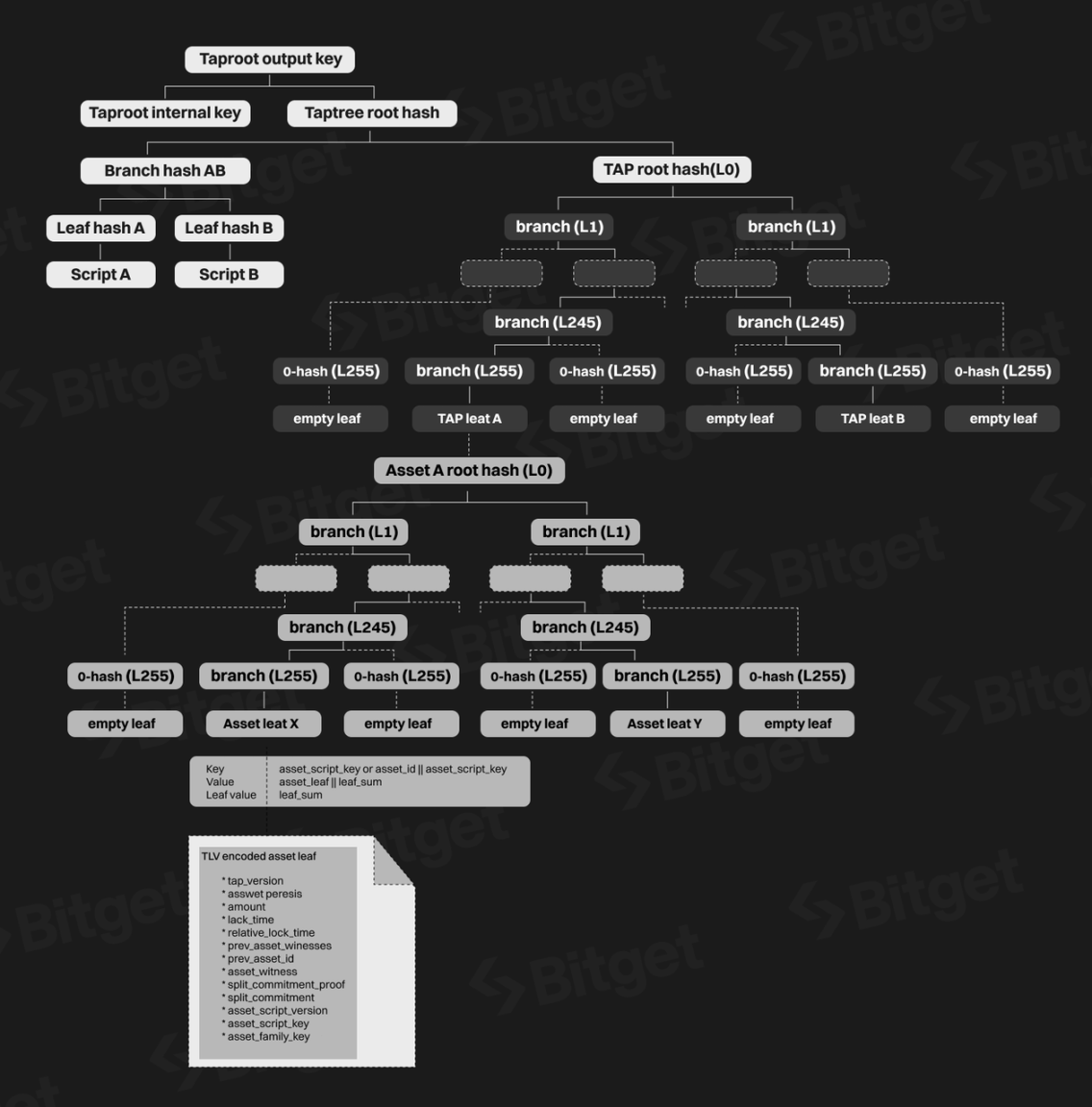
MS-SMTs Structure Diagram (Source: Taproot Assets on Lightning)
Current Status of the Taproot Assets Protocol
The Taproot Assets ecosystem is still in its early stages, with few mature projects, assets, and participants, and no mature trading market. The most famous leading project is Nostr Assets.
Nostr Assets has created two types of tokens, Trick and Treat. Nostr Assets has airdropped Taproot assets Trick and Treat to over 7900 Nostr addresses, with approximately 10,000 tokens per address, almost zero cost, and profits reaching over 1000 times.
NostrAssets products have the following features:
No gas fee: Transfer of Taproot Assets on NostrAsset website client or other decentralized social messaging applications on Nostr is done without gas fees.
Fair distribution: Nostr Assets has introduced the feature of fair distribution of Taproot Assets, similar to deploying contract tokens on Ethereum, setting token names, symbols, total supply, progress, avatars, and other social information.
Unique Advantages of the Taproot Assets Protocol
Good adaptability: Taproot Assets is fully based on UTXO, meaning it can integrate well with Bitcoin's native technologies such as RGB, Lightning, and DLC.
Low transaction costs: Taproot Assets are directly integrated with the Lightning Network. This means users can use Taproot to initiate Lightning channels and deposit BTC and Taproot assets into Lightning channels in a single Bitcoin transaction.
Low on-chain resource usage: Taproot Assets use Taproot to create assets on Bitcoin. Data is stored in the main root tree, and token metadata is stored by default on the creator's device or optionally in a off-chain data repository/indexer called "Universe." This means the on-chain footprint of large transactions is small.
More efficient: Users can mint three new categories of three different assets at once, paying a single mining fee, and then sell all newly minted assets to buyers using different Taproot assets for payment through a single vPSBT, without paying for each asset transfer.
Potential Issues with the Taproot Assets Protocol
High centralization: Taproot Assets rely on third-party storage indexers. If there are no storage indexers, these tokens will be permanently lost. Therefore, users either need to run a BTC full node and Taproot Assets client themselves, or rely entirely on a centralized server to transact Taproot Assets Tokens. This makes this solution the most centralized among BTC token protocols.
Unfair chip allocation: Users cannot directly send transactions to mint tokens on the BTC mainnet. Instead, there is a project address that issues (or registers) all tokens at once, and then the project transfers them to the Lightning Network. Allocation relies on institutions, and institutions are needed for endorsement and operation, giving project creators control over the entire asset issuance process.
Scaling Solutions
Bitcoin scaling solutions can be divided into on-chain scaling and off-chain scaling. On-chain scaling aims to directly increase transaction processing capacity by changing block size or data structure, for example, forking BCH and BSV from BTC. Off-chain scaling involves establishing a second-layer transaction network outside the Bitcoin main chain, such as the Lightning Network and sidechain technology.
Due to the technical difficulty of on-chain scaling solutions and the resulting split in BTC community consensus, off-chain scaling solutions have become mainstream. Currently, off-chain scaling solutions mainly include the following categories:
State channels: Such as the Lightning Network, which can transfer some high-frequency transactions off-chain.
Sidechain technology: Such as Liquid, Stacks, and Rootstock.
Others: Utilizing Rollup technology and fraud proofs of BitVM.
Lightning Network
What is the Lightning Network?
The Bitcoin Lightning Network is a second-layer protocol designed to improve the speed and efficiency of Bitcoin transactions. It achieves this by creating an additional transaction layer on top of the Bitcoin blockchain. The concept of the Bitcoin Lightning Network was initially proposed in 2015. This concept was detailed in a whitepaper by Joseph Poon and Thaddeus Dryja. The actual deployment of the Bitcoin Lightning Network occurred in 2018 when Lightning Labs announced the initial release of LND (Lightning Network Daemon), marking the formal implementation of the Lightning Network.
Why did the Lightning Network emerge?
The emergence of the Bitcoin Lightning Network was due to the significant increase in Bitcoin transactions as Bitcoin became more popular. However, due to Bitcoin's design of producing a block approximately every 10 minutes and the limited block size, the Bitcoin network began to face congestion issues, leading to longer transaction confirmation times and increased transaction fees. To address this problem, in 2015, Joseph Poon and Thaddeus Dryja published a whitepaper introducing the concept of the Lightning Network for the first time.
This proposal aimed to speed up transaction processing and reduce costs by establishing a second-layer network on top of Bitcoin. As a second-layer protocol, the Lightning Network allows users to establish payment channels outside the Bitcoin main chain for transactions. Transaction information is only recorded on the main blockchain when channels are opened and closed. This allows a large number of transactions to occur off-chain, significantly reducing the burden on the blockchain.
Current Status of the Lightning Network
As of November 22, 2023, according to Glassnode data, the current Bitcoin capacity of the Lightning Network is approximately 5341.2 BTC, equivalent to approximately $197,623,444.

Bitcoin Lightning Network Capacity (Source: Glassnode)
The current number of channels in the Bitcoin Lightning Network is 62,385, mainly concentrated in the United States, Canada, and Germany.
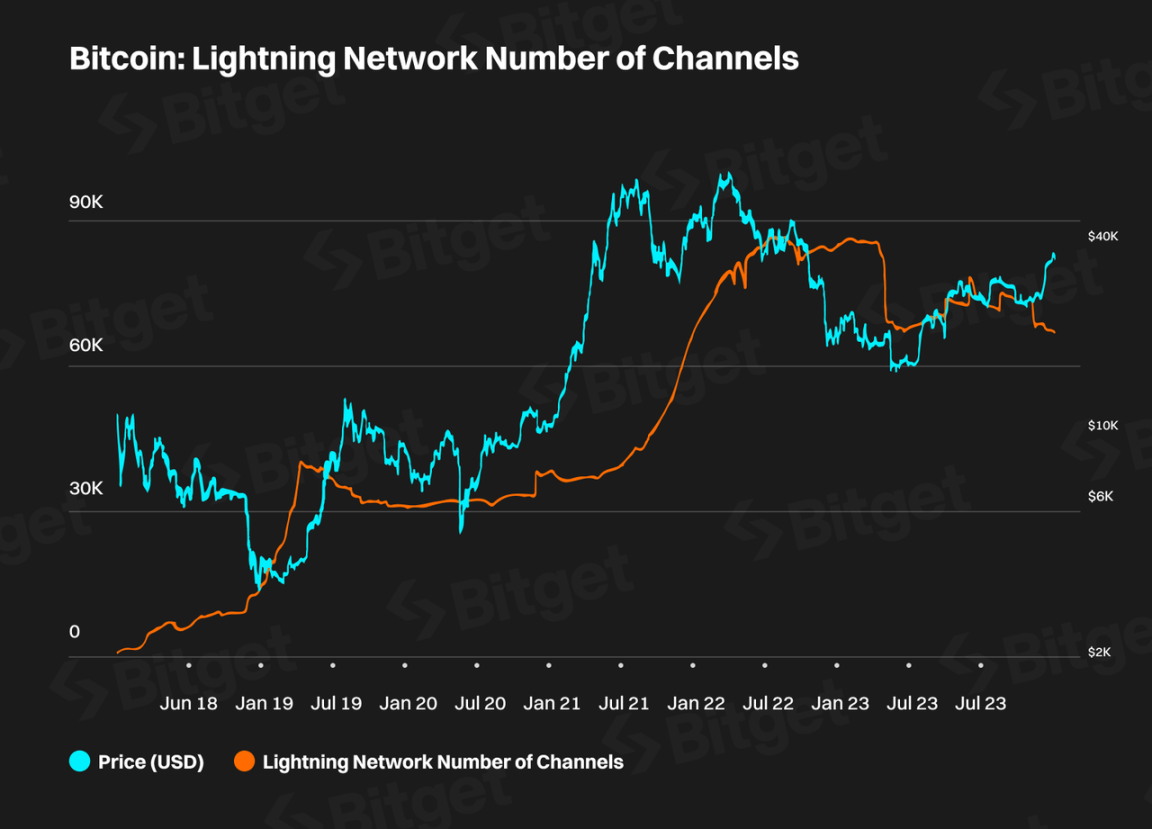
Number of Bitcoin Lightning Network Nodes (Source: Glassnode)
Unique Advantages of the Lightning Network
The main advantages of the Bitcoin Lightning Network are as follows:
Fast transactions: The Lightning Network allows for almost instant transaction processing, a significant improvement over transactions that typically require confirmation on the Bitcoin blockchain. If a transaction occurs within an established payment channel, the typical time to complete the payment is approximately 1-5 seconds.
Low cost: Since transactions occur off the Bitcoin main blockchain, transaction fees are significantly reduced, especially for small transactions.
Reduced main chain burden: By processing transactions off-chain, the Lightning Network reduces the burden on the Bitcoin main chain, helping to reduce network congestion and delays.
Support for micropayments: The Lightning Network is particularly suitable for processing small transactions, providing possibilities for micropayments in the digital economy.
Potential Issues with the Lightning Network
Potential issues with the Bitcoin Lightning Network include:
Complexity: Establishing and maintaining channels in the Lightning Network is more complex than simple Bitcoin transactions. Users need to understand how to open, manage, and close channels, increasing the barrier to entry.
Funds locking: In the Lightning Network, participants need to lock a certain amount of Bitcoin in channels to support transactions. This means that funds cannot be used for other purposes for a period of time.
Routing challenges: In the Lightning Network, payments need to find an effective path within the channel network between participants. This process needs to consider multiple factors, such as the capacity and fees of each channel. If the network cannot find a path effectively, transactions may fail, or transaction costs may increase.
Rootstock
What is Rootstock?
Rootstock is a smart contract sidechain built on Bitcoin, and RVM (Rootstock Virtual Machine) is a forked version of the Ethereum Virtual Machine, compatible with Ethereum smart contracts and tools for deployment and interaction. RBTC is the native currency of Rootstock, used to pay for the gas fees required to execute transactions. RBTC is pegged to BTC at a 1:1 ratio, and the two-way peg protocol Powpeg allows BTC to be transferred between the Bitcoin chain and the Rootstock blockchain. Rootstock shares security with Bitcoin, using merged mining and cryptographic and multi-signature technologies to ensure transaction security.
Developed by Argentinian RSK Labs, Rootstock received seed funding from Coinbase Ventures and other investors in 2016. In 2018, RSK Labs announced a merger with IOV Labs, forming the new company IOV Labs. Following the merger, IOV Labs secured $35 million in funding from Bitmain, Coinbase Ventures, Science Blockchain, and other investors. In 2019, they raised an additional $20 million in private funding.
Why Rootstock Emerged
The Bitcoin network is currently the most secure network in blockchain. However, due to Satoshi Nakamoto's initial design goal of positioning BTC as a peer-to-peer electronic cash system, the Bitcoin network does not have smart contract functionality. The goal of Rootstock's creation is to provide a way to expand BTC's capabilities without splitting the BTC community consensus, thereby bringing more decentralized applications to Bitcoin.
Current Status of Rootstock
Rootstock currently has a market value of $108 million, reaching a peak of $300 million and a recent low of $39 million over the past two years. According to official data, cross-chain locked BTC on Rootstock amounts to 3254 BTC (worth $120 million). According to Defillama data, the overall TVL of the ecosystem is $106 million, reaching a peak of $230 million. Several relatively well-known projects on Rootstock are listed below:
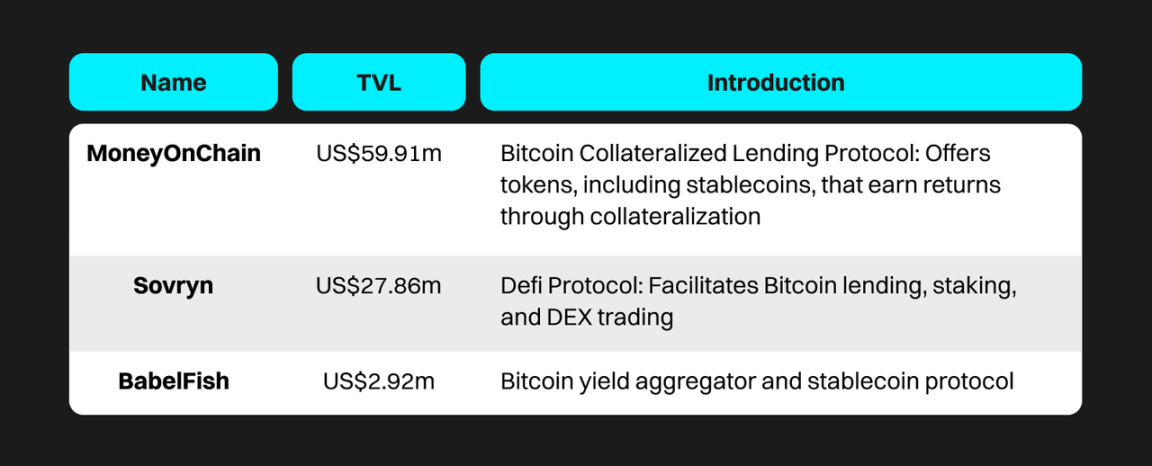
Data source: https://defillama.com/chain/Rootstock, statistics as of November 16th
Unique Advantages of Rootstock
Merged mining: Using DECOR+ (a unique variant of the Nakamoto consensus), it can merge mine with Bitcoin or any other blockchain with a shared Bitcoin block format and proof of work, allowing miners to receive rewards in both RSK and Bitcoin.
BTC two-way peg: RBTC, as the native currency of Rootstock, is pegged to BTC at a 1:1 ratio. The two-way peg protocol Powpeg allows BTC to be transferred between the Bitcoin chain and the Rootstock blockchain, providing convenience for introducing BTC assets to Rootstock.
EVM compatibility: RVM (Rootstock Virtual Machine) is a forked version of the Ethereum Virtual Machine, compatible with Ethereum smart contracts and tools for deployment and interaction.
Potential Issues with Rootstock
Insufficient performance scalability: Rootstock's scalability is up to 100 transactions per second, 20 times that of the Bitcoin network. However, compared to current high-performance L1 and L2 public chains, it is still insufficient to support high-concurrency applications.
Centralization in PowPeg: The notary protecting locked funds in Rootstock is a member of the PowPeg alliance, composed of well-known blockchain companies with high security standards. This third-party organization is responsible for locking and unlocking BTC funds, posing a centralization issue.
Inadequate value capture and slow ecosystem growth: With BTC's current market value reaching $700 billion, the entire Rootstock ecosystem captures only about $100 million in BTC assets, and the overall Defi projects in the ecosystem are less than 20, with slow TVL growth that has not exceeded the peak at the end of 2021.
Stacks
What is Stacks?
Stacks is a Bitcoin Layer2 project aimed at enhancing the functionality and scalability of Bitcoin. Developers can build smart contracts and DApps on top of Bitcoin's security foundation. Stacks was born in 2013 and has high recognition in the Bitcoin core community.
It is worth noting that since Stacks has not completed the Nakamoto upgrade, it does not currently rely entirely on the security of the Bitcoin chain. Instead, it is linked to the Bitcoin chain through the Proof of Transfer mechanism. Therefore, there is controversy over whether it is a "Layer2" project, with some referring to it as Layer1.5. After the Nakamoto upgrade is completed as originally planned, Stacks can become a more complete Layer2 project.
Why Stacks Emerged
After the early days of blockchain, people gradually developed more financial and other application needs for blockchain. At this point, the limitations of Bitcoin began to emerge, particularly in its lack of support for complex smart contracts and DApps. Stacks emerged to address this issue by building an additional layer to interoperate with the Bitcoin chain, enabling a wider range of applications while maintaining the high security of the Bitcoin network.
Current Status of Stacks
The ecosystem development of Stacks has been very slow. According to DefiLlama data, the TVL of Stacks is only about $20 million, with a historical peak TVL of only $45 million, and a lack of well-known projects in the ecosystem. Several relatively well-known projects on Stacks are listed below:
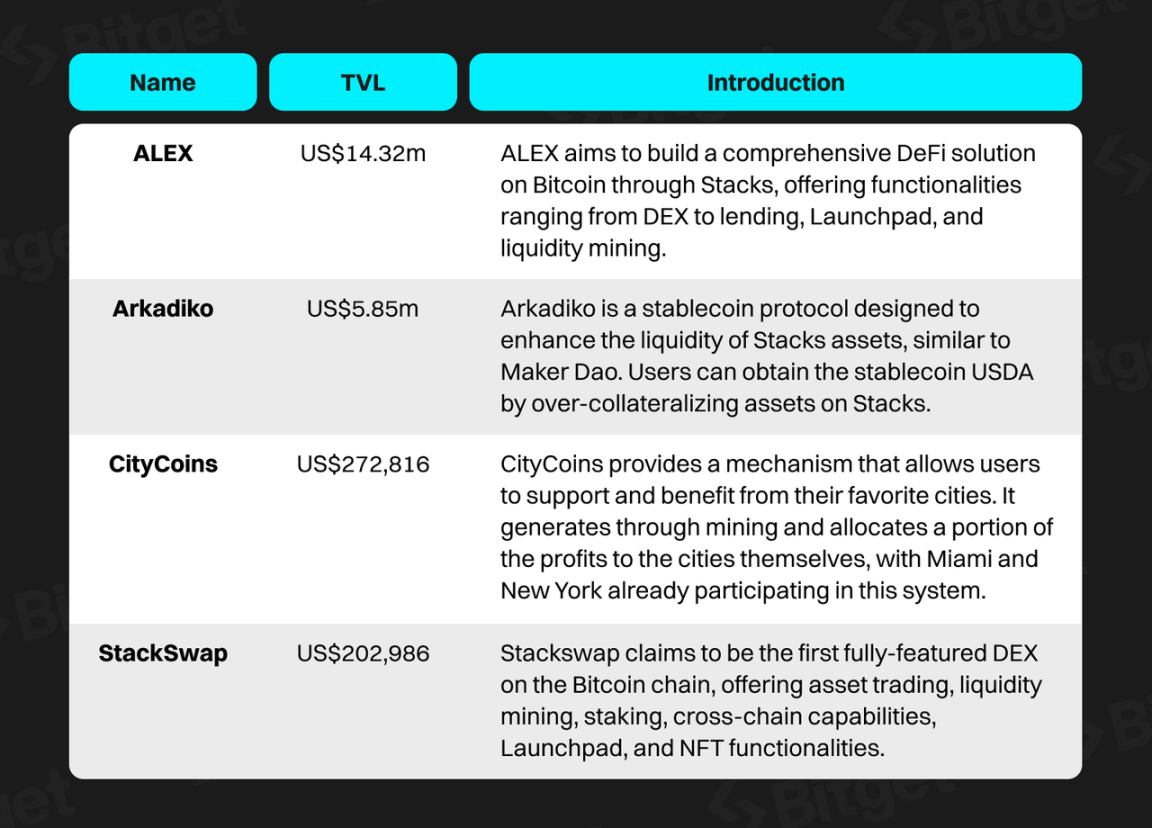
Data source: https://defillama.com/chain/Stacks, statistics as of November 16th
Unique Features of Stacks
Main speculation target for Bitcoin Layer 2: STX of Stacks is currently the main speculation target for Bitcoin Layer 2 in the market. When the Bitcoin ecosystem fully erupts, there are not many targets available to retail investors for low-threshold speculation in the secondary market.
Compliance narrative: In Q3 2019, Stacks became the first public offering project to obtain SEC compliance certification in the United States, giving it a natural advantage in compliance narrative and making it less susceptible to black swan events and FUD similar to some public chain tokens being considered securities.
Nakamoto upgrade: Expected to be launched in the first quarter of 2024, the upgrade is expected to achieve four things: sharing network security with BTC, settling transactions on the Bitcoin network, significantly increasing block generation speed (reducing from 10 minutes to 4-5 seconds), introducing Bitcoin-pegged assets sBTC to enable smart contracts to run faster and cheaper, and supporting multiple languages such as Solidity and EVM, facilitating the migration of existing EVM DeFi protocols.
Potential Issues with Stacks
Technical challenges: Stacks has relatively high technical development difficulty, and its Clarity language is relatively niche, leading to difficulty in increasing developer activity (although this may improve after the Nakamoto upgrade).
3.2.4 RGB Protocol
What is the RGB Protocol
The RGB protocol, developed by the LNP/BP Standards Association, is a smart contract system built on Bitcoin and the Lightning Network. It is an innovative attempt within the Bitcoin ecosystem to build more complex applications and functionality without sacrificing the core features of Bitcoin, such as security and decentralization.
Why RGB Protocol Emerged
The RGB protocol emerged to address the need for running scalable, file-based, and private smart contracts on UTXO blockchains (such as Bitcoin) while maintaining the security and decentralization of Bitcoin. Through the RGB protocol, developers can execute various complex functions such as token issuance, NFT minting, DeFi, and more, continuously stimulating innovation on Bitcoin while ensuring its security.
Current Status of the RGB Protocol
In April 2023, the LNP/BP Association announced the release of RGB v0.10, pushing RGB into the phase of an upcoming commercial system. RGB may bring fully supported smart contracts to the Lightning Network, but further development will require ongoing exploration by various projects.
3.2.5 BitVM
What is BitVM
BitVM is a computing paradigm that implements Turing-complete smart contracts on the Bitcoin network. Its core idea is to verify computation results on Bitcoin rather than directly executing computations, similar to Optimistic Rollups. In this system, a prover claims that a function has a specific output for a given input. If this claim is false, verifiers can provide concise fraud proofs and penalize the prover. Using this mechanism, any computable function can be verified on Bitcoin.
Why BitVM Emerged
BitVM emerged primarily to address the need for more complex and Turing-complete smart contracts on the Bitcoin network. It extends the capabilities of Bitcoin, allowing users to execute more complex computations and smart contracts while maintaining the core features of the Bitcoin network. Unlike the RGB protocol, BitVM emphasizes off-chain computation and fraud protection to ensure the integrity of contract execution and transactions.
Current Status of BitVM
It is currently in the whitepaper stage.
2. Which Sectors in the Bitcoin Ecosystem Have Strong Wealth Effects
1. Ordinals Protocol's BRC20
1.1 Huge Wealth Effect of BRC-20
According to GeniiData, as of December 4th, there are already 56,092 different tokens using the BRC20 standard in the market. The market size of BRC20 tokens has now exceeded $4 billion, compared to $100 million in March of this year, an increase of over 40 times.
Currently, the market value of the top BRC20 token, $ORDI, has reached as high as $902 million, with a nearly 1178% increase in the past three months since September, creating a remarkable wealth effect. BRC20 assets with strong wealth effects typically have the following characteristics in terms of market value and price increases:
Memorable token names: Most assets are related to Bitcoin and the ordinal culture, such as $ORDI and $SATS, or use animal names, such as $RATS, continuing the trend of the 21-year Meme craze (such as DOGE at the time).
Originality: These assets are not simple copies of other memes but are unique IPs with distinctive features.
Community strength: These projects have strong community support, a clear vision, and promotion plans. The early holders' chips are relatively dispersed, and participants in the community can effectively drive the development of the project.

In addition to innovative asset issuance methods and original naming, the rapid development of BRC20 assets has been driven by multiple factors such as consensus on funds, strong narratives, and external forces.
1.2 Reasons for Strong Wealth Effects
Consensus on Funds
Consensus on the minting of ordinals: Taking the representative SATS as an example: SATS has a total supply of 21 trillion, which is one hundred million times that of Bitcoin. The maximum minting amount is one hundred million at a time, meaning it would take 21 million minting sessions to complete all minting. The rough estimated gas cost for 100% mint out is as high as $15 million. Therefore, at the beginning of its launch, many users did not believe that this BRC-20 token would be fully minted. However, on September 24th, the minting progress of SATS reached 100%, with a total of 21,107,258 minting sessions, 36,061 holders, and minting since March 9, 2023, taking 6 months, indicating strong consensus and funding participation in this token.
Increased miner income: The launch of the Ordinals protocol has significantly increased Bitcoin miners' transaction fee income over the past three months. The on-chain transaction fee ratio gradually increased from 1.7% in August to a peak of 19.57% on November 10th, creating substantial additional income for miners. This has further strengthened the support of the large group of miners for BRC20 and the Bitcoin ecosystem.
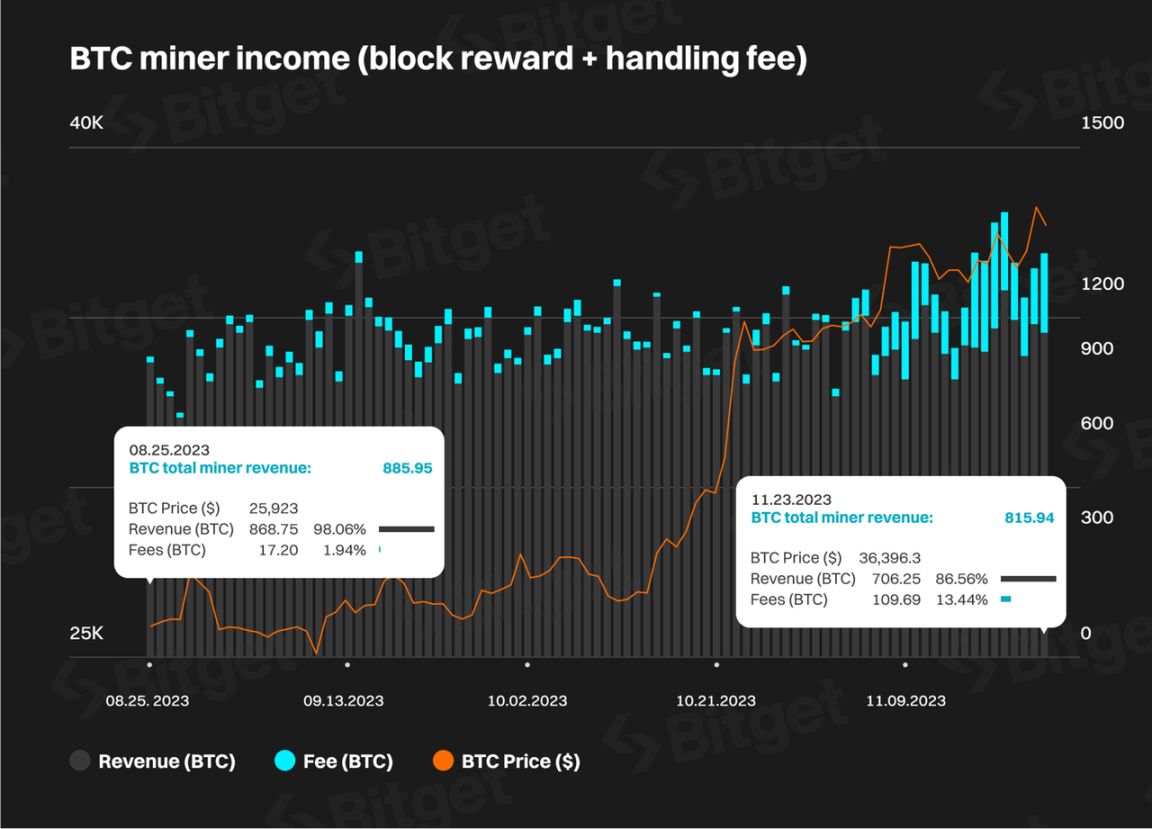
Data source: oklink
Strong Narratives
Fair distribution: After all BRC20 tokens are generated, all users holding BTC only need to pay gas fees to mint, allowing ordinary users to participate fairly in the "primary market." This fairness gives BRC20 tokens strong consensus at the beginning of their creation, which will be helpful for subsequent price increases.
BRC20 naming similar to ERC20: The naming of BRC20 is inspired by ERC20 on Ethereum, reminiscent of the wealth creation myth of ICOs when ERC20 was first introduced. Therefore, after the launch of BRC20, funds and communities used this narrative for promotion, making it easier for more people to understand and be willing to learn about it.
External Driving Forces
Influence of KOLs and community consensus: The Bitcoin ordinal community began to promote on March 10, 2023, and in the following months, due to the wealth effect of ORDI, many KOLs also participated in promotion, further attracting the attention of retail investors and early investors. In addition, the low entry barrier for BRC20 participation has led to a large number of users outside the circle participating under the leadership of KOLs. Since BRC20 tokens have a low initial market value and are prone to rapid increases, the continuous wealth effect has led many users to hold onto their tokens, further sustaining the wealth effect.
Support from centralized exchanges: The listing of BRC-20 tokens on mainstream centralized exchanges such as Bitget, Binance, OKX, and Gate has greatly improved the liquidity of BRC-20 tokens. For top BRC-20 assets such as ORDI and SATS, the listing on centralized exchanges has increased their exposure and attracted more trading users, while users are more inclined to hold assets with strong liquidity.
1.3 Will the Wealth Effect Continue
BRC20 Token Wealth Effect
The wealth effect of BRC20 tokens needs to be viewed in two categories: the first category is the top token $ORDI, and the second category is the mid-to-tail BRC20 tokens.
For the first category, $ORDI, there are two valuation estimation logics:
First, comparing it to the top Meme coin SHIB on ETH: As one of the most prominent meme coins on BTC, it is likely to experience a significant increase. With a current market value of about $400 million, if compared to the $4.9 billion market value of the top Meme coin SHIB on ETH, there is a potential for over 12 times increase.
Second, considering it as a top project in a specific niche: Even without comparing it to the top Meme coins on ETH, if it is seen as a top coin in a specific niche, historically, such narrative-based projects can often enter the top 50 in market capitalization during a bull market. The 50th project in market capitalization is RNDR, with a market capitalization of $1.26 billion. Therefore, with a current market capitalization of $400 million, $ORDI may still have 3-4 times growth potential.
For the second category, mid-to-tail BRC20 tokens, there may be a wealth effect in the short term when they are first minted, but as funds leave and community consensus weakens, most mid-to-tail BRC20 tokens may become worthless. Therefore, quick entry and exit are necessary. When the trend shifts, a rapid decline in the BRC-20 sector within a certain period may be unavoidable, and a liquidity crisis and value depreciation of mid-to-long tail assets are likely to occur.
User Participation Opportunities
As a user, participation in BRC20 mainly involves two types: minting in the primary market and buying and selling in the secondary market.
Primary minting:
1) Participation in the primary market minting of BRC-20 assets is mainly done using non-custodial wallets that support Bitcoin chain and inscription minting. For example, through the website UniSat (https://unisat.io), users can directly choose the token name and quantity they want to MINT and use the Inscribe function to mint. When minting, users can check the Gas level on (https://mempool.space/zh/) and choose the appropriate Gas for payment. During the FOMO period, consider selecting a high priority Gas fee to increase the minting success rate.
2) Information on participating in the primary market minting of BRC-20 assets mainly comes from Twitter project parties and the Ordinals BRC-20 trading market. Individual investors need to conduct thorough research on the project parties and evaluate the artistic value of their NFTs and the potential community preferences to decide whether to participate in the new issuance.
Secondary market trading:
1) BRC20 assets such as $ORDI, $SATS, $RATS can be directly traded on centralized exchanges like Bitget. BRC-20 assets on centralized exchanges have much better liquidity than the OTC market and do not require the high Gas fees and longer on-chain transaction processing time of the BTC chain.
2) For BRC20 tokens already in circulation in the secondary market, focus on inscription assets with "strong consensus on funds, high chip dispersion, and high social media discussion," just like early SATS and RATS.
Atomicals Protocol's ARC20 and Realm
Atomicals, due to its UTXO binding design, is closer to the native BTC ecosystem compared to Ordinals. Additionally, the protocol introduces a mining mechanism through the Bitwork algorithm, allowing users to adjust mining difficulty by specifying parameters when issuing tokens. This approach has gained popularity among many players in the community. Atomicals currently has two sectors with strong wealth effects: ARC20 and Realm.
ARC20
ARC20 is the first token issuance protocol to use POW for inscription minting. Its basic unit is composed of the smallest unit of Bitcoin, Satoshi, so each ARC20 token equals 1 Satoshi, meaning each ARC20 token is backed by 1 Satoshi in value. Unlike BRC20, the minting of ARC20 tokens may require users to consume a certain amount of computing power in addition to Gas, depending on the settings of the asset issuer.
ARC-20 Wealth Effect
According to Atomical Market data, as of November 20th, there are a total of 17 different tokens using the ARC20 standard, with a total market value of over $40 million. ATOM, as the first token issued based on the ARC20 protocol, is currently the most popular in this category. Each ATOM currently requires 6000 SATS, and excluding the consumption of Gas and computing power during minting, the increase has reached 6000 times. If the minting cost is estimated at $10, there is also an increase of approximately 250 times.
Reasons for Strong Wealth Effect of ARC20
1) PoW mining gameplay: ARC20 introduces the gameplay of PoW mining through the Bitwork algorithm. This fair launch mining method allows users to relive the sentiment of mining BTC through CPU when it was first introduced, making them feel that this method is more in line with the BTC ecosystem and more decentralized.
2) Developer-friendly indexer: ARC20 has encapsulated token issuance and transfer, and many developers use the Python language for indexer development, allowing more developers to participate and facilitate the development of the protocol.
3) Community support: Some long-time players in the BTC community strongly support this method of mining and issuing coins through computing power. They have written many tutorials on setting up Atomicals nodes, and as the inscription market heats up, related information is spreading more widely, leading to a growing player community.
However, it should be noted that at this stage, ARC20 has poor liquidity and depth. According to Atomical Market data, there are currently only 17 ARC20 tokens, with only about 5,000 holders of ARC20 tokens, and many ARC20 tokens are almost not traded. The leading token of ARC20, ATOM, also experiences extremely volatile price fluctuations due to poor liquidity. Therefore, at this stage, there are both opportunities and risks with ARC20.
User Participation Opportunities
Primary minting:
1) Minting through Atomiclas public nodes or the Atomiclas trading platform. According to their official documentation, there are currently three public nodes available for use. Users can participate through the API as described in the documentation, and can also participate in minting through the graphical interface on the Atomical Market platform or SatsX platform.
2) Minting through private nodes in Atomiclas. Users can set up Atomiclas nodes using their open-source code and participate in minting through their own nodes. This method has a certain technical threshold, and with proper node configuration, it offers higher stability compared to public nodes.
Secondary market speculation:
1) Currently, Atomical Market and SatsX support the trading of ARC20, and users can sell or buy corresponding inscriptions on these two platforms, using core data such as price changes and trading volume to assist in trading.
2) In addition to trading platforms, users can also choose the C2C method to conduct "face-to-face" transactions within the community, but this method carries a certain reputation risk.
2.2 Realm
Realm is a protocol based on the Atomicals protocol that uses prefixes to identify identities. In addition to serving as traditional domain name identifiers, Realm can also be used to manage subdomains using its prefixes.
For example, if the Realm protocol registers "bitget" as the main domain name, then the holders of subdomains under the main domain name, such as bitget.aaa/bitget.bbb/bitget.ccc, etc., will need to pay a certain registration fee to the holder of the main domain name "bitget." This design makes the application methods around the main domain name very diverse, such as for brand building or DAO governance.
2.2.1 Realm Wealth Effect
As the Realm protocol is still in its early stages, the total market trading volume is only 1 BTC (data source: Atomical Market), and there is currently no significant wealth effect. However, its innovative gameplay and economic model design have sparked widespread discussion. With decentralized identity (DID) gradually becoming the mainstream identity in social contexts, Realm may also develop products similar to ENS on the BTC network. Before this happens, some high-quality and unclaimed Realms may hide good opportunities.
2.2.2 Will Realm Continue to Have a Wealth Effect
Since the release of the Atomicals protocol over two months ago, the practical application of Realm has not yet been implemented, leading to significant uncertainty. The future wealth effect of Realm mainly depends on two factors:
1) Large-scale adoption of the Atomicals protocol.
2) The increasing importance of identity identification within the BTC ecosystem.
2.3 How Users Can Participate
Similar to participating in ARC20, there are mainly two ways: participating in primary market Mint, requiring the Atomicals node client; and participating in secondary market trading, buying and selling using BTC on the Atomical Market and SatsX platforms.
3. PIPE Token under the PIPE Protocol
$PIPE is the first token of the PIPE Protocol and also the top token.
3.1 Wealth Effect of PIPE
As $PIPE is the first token issued by Beny based on the PIPE Protocol, according to community data, it has seen an increase of approximately 250 times, excluding the cost of about $4 during minting.
3.2 Reasons for Strong Wealth Effect of PIPE
The wealth effect of PIPE comes from the community's recognition of Beny. Beny is very active among BTC developers and has composed the TRAC System through the release of multiple protocols. The early-issued BRC20 token $TRAC has also been hyped by the community, with a current market value of $62.7 million and an increase of over a thousand times (data source: OKX Marketplace). Therefore, $PIPE has been highly sought after by many users since its issuance.
3.3 Will PIPE Continue to Have a Wealth Effect
$PIPE is still worth paying attention to for several reasons:
1) The PIPE Protocol is developed based on Casey's Runes protocol, and the current technical solution has great potential for the issuance of assets from the BTC network.
2) The governance token $TAP of the PIPE Protocol has not yet started circulating, and holding $PIPE may have a certain expectation of airdrops.
3) The infrastructure of the PIPE Protocol is still under development, and as the infrastructure gradually improves, it will also benefit $PIPE.
3.4 How Users Can Participate in PIPE
Similar to participating in BRC20, there are mainly two ways: participating in primary market Mint, spending a certain amount of BTC as Gas for Minting; and participating in secondary market trading, buying and selling using BTC on the SatsX platform.
4. Tokens in the Bitcoin Scaling Sector
Bitcoin scaling has always been one of the mainstream narratives in the Bitcoin ecosystem. Therefore, when there is a significant technological innovation or performance breakthrough that becomes a hot topic in the market, tokens in this sector will experience significant increases. Two representative tokens worth paying attention to in this sector are Rootstock (RIF) and Stacks (STX).
4.1 Rootstock (RIF)
The RIF token has mainly followed the narrative of BTC in its history. It currently has a market value of $100 million, and at its peak in late 2021, it reached $300 million. As a scaling sector of BTC, it currently ranks second in market value among issued projects and has the characteristic of relatively small market value, making it easy to hype.
Due to its insufficient performance expansion and slow ecological growth, the future wealth effect of RIF mainly depends on two factors:
- Further breakthroughs in performance
- Significant growth in ecological assets; this will directly benefit the price of RIF
If there is no significant progress in performance or ecology, RIF will continue to be one of the targets in the ecological sector and become a supplementary project.
4.2 Stacks (STX)
Here, it is important to briefly mention the PoX (Proof of Transfer) consensus algorithm mechanism of Stacks: In Stacks, there are two roles, "miners" and "transaction validators." Transaction validators need to stake STX tokens to mine BTC, while miners need to stake BTC on the Bitcoin main chain to mine STX. It is because of this mechanism that the beta returns of STX are more closely related to the overall market, and it only briefly shows independent market trends at specific times, such as the significant increase in value during the recent compliance narrative hype.
If the expected Nakamoto upgrade in Q1 next year proceeds as planned, with the security sharing between STX and the BTC network, a significant increase in block speed, and the introduction of sBTC, STX may attract attention from the market and capital, ushering in a new wave of hype.
Opportunities and Risks Faced by Various Players in the Current Bitcoin Ecosystem
1. Individual Investors
Opportunities:
- Enjoy basic returns: Users participating in asset issuance protocols within the Bitcoin ecosystem indirectly hold Bitcoin, which has always been the leading asset in the cryptocurrency industry, leading to the industry's most basic beta returns.
- Fair sales: Currently, the issuance of most assets in the Bitcoin ecosystem is open and fair, providing more opportunities for ordinary users to participate in early projects and have a greater chance of obtaining excess returns.
- Incomplete infrastructure: The Bitcoin ecosystem is currently in a stage of fierce competition, and we have seen many asset protocols emerge within the Bitcoin ecosystem. Most of these asset protocols can only be participated in through clients in the early stages, without mature trading markets. Therefore, early participants are more likely to capture excess returns.
Similarly, individual investment in the early Bitcoin market may encounter various risks, mainly:
- Lack of basic knowledge of Bitcoin: For example, in the case of Ordinals, if users inscribe on UTXO without paying attention, they may mistakenly use the inscribed UTXO as Gas payment or for other purposes, resulting in the loss of the inscription value on the UTXO.
- Early-stage ecosystem: Early-stage ecosystems mean opportunities but also hidden crises, such as fatal vulnerabilities in project protocols leading to asset theft or double spending issues, requiring investors to be fully aware of the risks of participation.
2. Exchanges
2.1 Listing related tokens to attract new users and brand exposure
Opportunities:
- The listing of popular BRC-20 tokens can attract a large number of BTC chain players to the exchange, and the huge wealth effect can bring higher trading volume and a good reputation to the exchange. The exchanges that were the first to list ORDI and SATS have already enjoyed this dividend.
- The first time the assets of various new BTC ecosystem protocols (such as Atomicals, Runes, PIPE, Taproot Assets protocol) are listed, they can exclusively attract specific users who are interested in these assets, as well as users who want to participate in such speculation but are burdened by high learning costs and can only trade on centralized secondary markets.
In the Bitcoin Layer2 Stacks ecosystem, there are some low-market-value projects, such as ALEX, Arkadiko, etc., that have already been issued. If Bitcoin Layer2 experiences rapid development and a surge of funds, early listing of these low-market-value tokens can seize the opportunity and allow users to gain significant wealth effects.
Risks:
Potential technical risks: For exchange technical personnel who are more familiar with EVM public chains and other mainstream public chains, there are known challenges and unknown risks in integrating new ecosystem assets. For example, UniSat Wallet has suffered from double spending attacks. The rapid development of the Bitcoin ecosystem may expose new issues. If exchanges do not update the client code for certain assets in a timely manner, it may lead to issues such as double spending.
Market-making and low liquidity risks: Currently, in the Bitcoin ecosystem, especially in the trading of inscription assets, there is a lack of mature AMM markets like Uniswap on Ethereum, resulting in significant liquidity issues. Market-making departments of exchanges bear significant pressure and risks.
2.2 Cloud Mining Products
Opportunities:
According to Cointelegraph, on November 12, Bitcoin miners received over $44 million in block rewards and transaction fees, reaching a new high for the year. The popularity of BRC-20 and other assets has driven the consumption of gas on the BTC chain, amplifying the profitability of miners. Exchanges offering cloud mining products and charging a certain fee for hash rate leasing services can achieve a win-win situation with users in the thriving development of the Bitcoin ecosystem.
Risks:
Exchanges mainly need to bear the operational and compliance risks of cooperating mining farms, requiring exchanges to have good due diligence capabilities to find reliable and capable mining farms to partner with.
2.3 NFT Market
Opportunities:
Several leading exchanges now have their own non-custodial wallet products or have their own NFT marketplaces, where they can list various NFTs from the Bitcoin ecosystem, such as BRC-20 NFTs and Stacks NFTs.
Risks:
The main risk is the inability to profit due to low liquidity and low trading activity. Exchanges' efforts in the still immature BTC ecosystem NFT market may yield little results, leading to losses in certain business lines for exchanges. However, it cannot be denied that this is a business worth trying.
3. Project Parties
3.1 Asset-based Project Parties:
Opportunities:
For project parties, Taproot Assets provides the most complete and user-friendly service. Users cannot directly send transactions to mint tokens on the BTC mainnet. Instead, there is a one-time issuance (or registration) of all tokens by the project party, which are then distributed on the Lightning Network. Depending on institutional endorsement and issuance operations, the project creator controls the entire asset issuance process. These assets, unlike ERC-20, have greater asset value and purchasing power due to Bitcoin's larger user base and asset value. Additionally, apart from BRC-20, various protocol assets are scarce and in early development stages, making it an undoubtedly blue ocean market from a competitive standpoint.
Risks:
Risk of fund loss: Various protocols are currently not mature technically, posing a risk of fund loss. For example, on the night of April 23, a BTC address starting with bc1pw conducted a double spending attack on UniSat's BRC20 Marketplace. Although trading was promptly suspended by UniSat, this risk is not something that project parties can repair or avoid.
3.2 Tool-based Project Parties:
Opportunities:
Low entry barriers: For project parties, the business models of trading markets, Bitcoin wallets, and market websites are relatively uniform. Although the profit points are different, they are essentially traffic businesses. The Bitcoin ecosystem is still in a blue ocean market. Currently, apart from Unisat having the potential to become a leader in the BRC-20 asset field, the competitive landscape for various projects has not been determined, making it relatively easy for project parties to enter the market at this time.
Larger market: Bitcoin's larger asset value and user base also mean greater profit prospects compared to the Ethereum network.
Risks:
Due to the complexity of Bitcoin technology, lack of product technical capabilities, or user awareness, there is a risk of fund loss, leading to public relations and customer complaint risks.
3.3 Protocol-based Project Parties:
Opportunities:
Large valuation space: These project parties mainly provide public services, so the products generally lack a clear profit model. However, due to the speculative demand for asset-based projects, as basic infrastructure serving as public services and traffic entry points, they bear the capability to facilitate user and project transactions on the Bitcoin network. Due to Bitcoin's asset volume, leading projects can achieve significant valuations.
Risks:
High uncertainty: Due to the complexity of Bitcoin technology and the different innovative approaches and focuses of various protocols, combined with uneven product technical capabilities, there is a high development risk for such project parties.
4. Miners
Miners play a crucial role in the Bitcoin network, using proof of work to have the opportunity to validate transactions and write new transaction information into new blocks, earning Bitcoin block rewards and processing fees.
Opportunities:
Increased miner income: With the thriving Bitcoin ecosystem, especially the high enthusiasm for BRC-20 tokens, there is a need to record more information on the network, which requires miners to receive more fees. This has led to recent record-high levels of income for Bitcoin miners, mainly due to the increase in transaction fees.
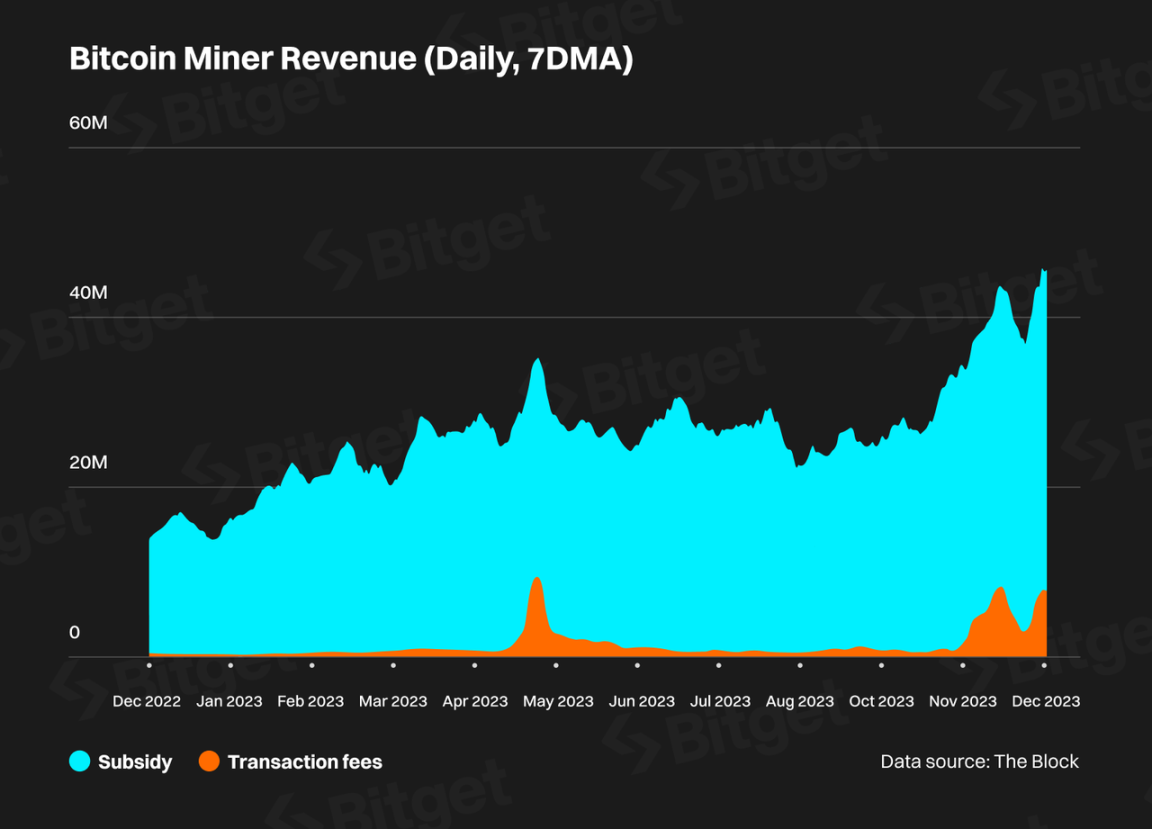
Bitcoin Miner Income (Source: The Block)
Improved revenue for mining machine manufacturers: Some mining machine manufacturers are also preparing to lay out BTC ecosystem projects, incubating projects that can facilitate quick BTC payments, issue on-chain NFTs, tokens, etc., to attract more users to the BTC ecosystem and increase demand for using the Bitcoin network. This is a favorable method to increase Bitcoin miner income and help mining machine manufacturers sell machines more effectively.
Risks:
High income uncertainty: Miner income is directly related to the activity of BTC ecosystem projects and users. If the demand for transactions significantly decreases, miner income will also experience a noticeable decline. This leads to significant fluctuations in miner income, failing to achieve the expected static return rate.
5. Investment Institutions
For the Bitcoin ecosystem, investment institutions are still in a very early stage of layout, and some are even in a wait-and-see phase. Representative investment institutions that have relatively early layouts include Digital Currency Group, Rabbit Capital, Foresight Ventures, HashKey, and OKX Ventures.
Opportunities:
Allocating BTC in the secondary market: Wall Street investment institutions, large listed companies, family funds, etc., can enjoy beta returns from the development of the Bitcoin ecosystem by allocating BTC.
Primary market investment in BTC ecosystem-related supporting projects: Investment institutions can delve into various directions within the BTC ecosystem, especially investing in infrastructure projects needed in the early stages of the ecosystem, including wallets, trading markets, domains, and market websites under various Bitcoin protocols.
Risks:
Difficulty in early investment due to fair issuance: Many projects in the BTC ecosystem, such as BRC20 projects, have fair issuance mechanisms, putting ordinary users and investment institutions on an equal footing. This makes it difficult for investment institutions to invest early as they have in the past. The leading project ORDI, with a free minting model, now has a market value exceeding $500 million, and no investment institution could participate in primary market subscriptions.
High uncertainty in the ecosystem: BTC ecosystem projects have not yet had a very successful project to expand the performance of the Bitcoin network and support its funds. The ecosystem is in a bottleneck period, with significant uncertainty and unclear profit models, making it difficult to invest according to traditional investment concepts, and short-term losses may occur.
IV. Possible Future Trends and Bottlenecks in the Bitcoin Ecosystem
It is difficult to predict whether the Bitcoin ecosystem can maintain its current growth trend, but we can still glimpse the changes occurring within the Bitcoin ecosystem through data.
As an important indicator of the Bitcoin ecosystem, UTXO, we have seen a linear increase in the number of Bitcoin UTXOs since the birth of the Ordinals protocol. This indicates that protocols represented by Ordinals, which issue Bitcoin assets, have made the Bitcoin ecosystem and community more prosperous. The increase in Bitcoin UTXOs to some extent represents the coverage of Bitcoin to more people. As a global cryptocurrency, the acceptance and participation of more people means a stronger consensus. This is the foundation of the development of the Bitcoin ecosystem and a prerequisite for Bitcoin's future higher market value.
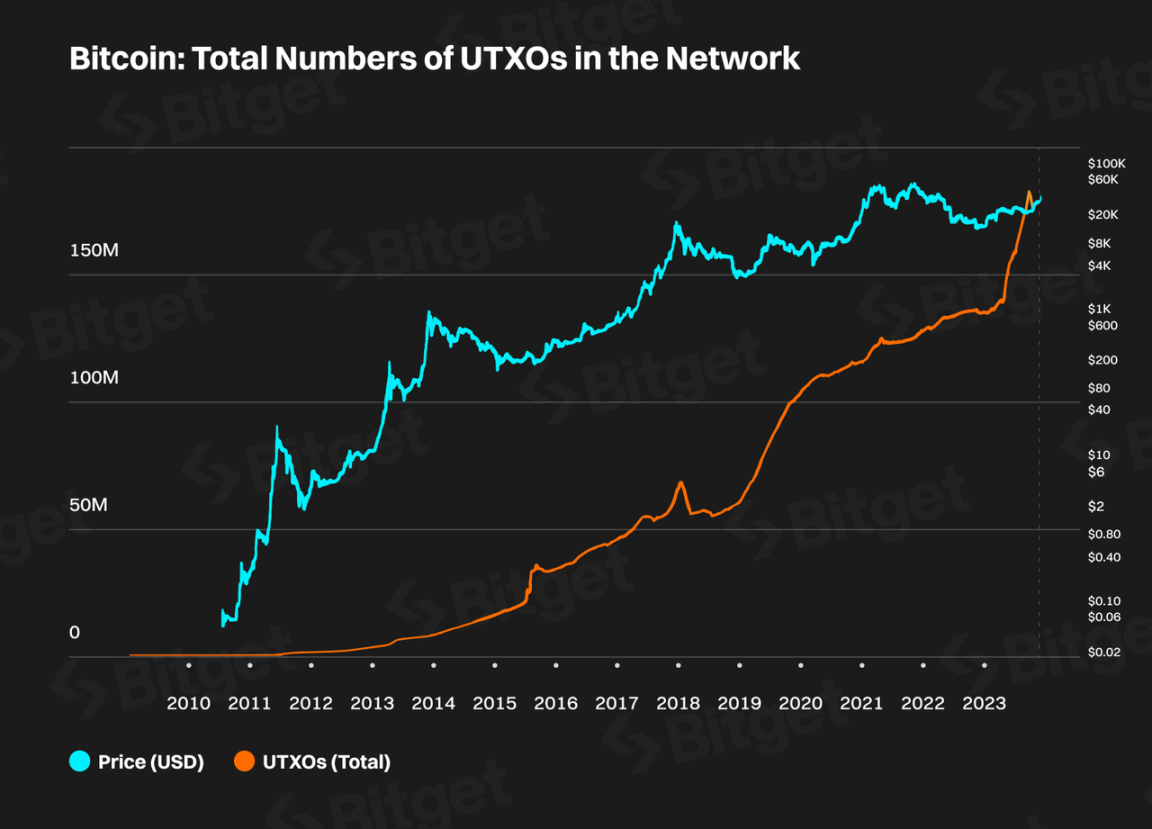
Comparison of Bitcoin UTXO count with Bitcoin price (Source: Glassnode)
However, it is evident that the future of the Bitcoin ecosystem will encounter bottlenecks, mainly for two reasons: 1) Bitcoin itself has poor scalability, making it difficult for applications to land, and it may be stuck in the current problem of insufficient scalability, which may ultimately affect the speed and height of the entire Bitcoin ecosystem's development; 2) Bitcoin core developers have relatively conservative views, and in fact, some developers oppose or even dislike various asset protocols in the current Bitcoin ecosystem. Therefore, if the coin price falls in the future or innovation stagnates, the ecosystem's development may be mired in a quagmire.
Based on the above possibilities, the Bitget Research Institute has made the following 6 predictions regarding the future trends of the Bitcoin ecosystem:
Prediction 1: If the Bitcoin ecosystem continues to develop, the significant increase in Bitcoin demand will lead to the price of BTC breaking through the previous high in the next bull market phase, possibly reaching $100,000.
Prediction 2: ORDI, as a leading currency in the Bitcoin ecosystem, will enter the top thirty in terms of circulating market value in the next bull market.
Prediction 3: The future Bitcoin NFT market will experience a growth of over 100 times.
Prediction 4: There will be hundredfold opportunities on protocols such as Ordinals, Atomicals, and Taproot Assets.
Prediction 5: In the short term, the Bitcoin ecosystem will maintain a "one project, one protocol solution" status, with Bitcoin's protocol types continuing to maintain a situation of diverse offerings; in the long term, the Bitcoin ecosystem will introduce a virtual machine and a unified developer compilation environment.
Prediction 6: The Lightning Network will be the biggest technological support to help Bitcoin payments continue to be adopted on a larger scale, and there will be more assets issued on it in the future.
V. Conclusion
Entering 2023, the price trend of Bitcoin is positive, rising from $16,500 at the beginning of the year to the current $40,000. With the high probability approval of Bitcoin spot ETFs, the quadrennial halving market, and the slowdown of US interest rate hikes, the wealth effect of Bitcoin is highly likely to continue. In addition to the wealth effect of BTC price itself, the overflow of market funds into its ecosystem is very evident.
The most obvious case is the resurgence of the entire BRC20 track since November, including ORDI, SATS, and other BRC20 tokens, creating a significant wealth effect. This has also driven the development of the entire Bitcoin ecosystem, demonstrating the potential of being the engine of the bull market. The current focus on the Bitcoin ecosystem is on two main aspects: asset issuance protocols, mainly covering Ordinals, Atomicals, Runes, PIPE, Taproots Assets, and scaling solutions, mainly covering Lightning Network, RSK, Stacks, RGB, BitVM.
The main sectors in the Bitcoin ecosystem with significant wealth effects at present are: BRC-20 assets under the Ordinals protocol, ARC-20 and Realm under the Atomicals protocol, PIPE under the PIPE protocol, and tokens in the Bitcoin scaling sector (RIF, STX). This article analyzes the reasons why these assets have wealth effects and introduces ways for investors to participate.
In addition to technological innovation, the prosperity of the Bitcoin ecosystem depends on the participation of various market participants, mainly including individual investors, exchanges, project parties, miners, and investment institutions. Therefore, this article analyzes the opportunities and risks for the 5 categories of groups in the development of the Bitcoin ecosystem, providing reference for investment and business expansion.
Based on the above analysis, this article provides the Bitget Research Institute's judgment on the future trends and potential bottlenecks of the Bitcoin ecosystem. Overall, based on future macroeconomic conditions and market conditions, the Bitcoin ecosystem has a promising development outlook. Not only is there a large appreciation space for assets such as BTC, ORDI, and Bitcoin NFT, but there will also be new hundredfold opportunities in the Bitcoin ecosystem, and the Lightning Network will be the biggest technological support to help Bitcoin payments continue to be adopted on a larger scale in the short to medium term.
VI. Reference Tools and Websites
1. Trading Markets
BRC-20 & NFT
Unisat: https://unisat.io/market
OKX Marketplace: https://www.okx.com/web3/marketplace/ordinals/brc20
Magic Eden: https://magiceden.io/ordinals
Ordinals Wallet: https://ordinalswallet.com/collect
Gamma: https://gamma.io/ordinals/marketplace
ARC-20 & NFT
Atomical Market: https://atomicalmarket.com/marketplace/token
SatsX: https://www.satsx.io/marketplace/atomicals/ft/sort?page=1
PIPE & NFT
SatsX: https://satsx.io
2. Minting
BRC-20 & NFT
Unisat: https://unisat.io/inscribe
iDclub: https://idclub.io/brc20
LooksOrdinal: https://looksordinal.com
ARC-20 & NFT
Atomical Market: https://atomicalmarket.com/inscribe
SatsX: https://www.satsx.io/inscribe/atomicals
PIPE & NFT
Inscrib3: https://inspip.com/mint
SatsX: https://satsx.io
ppline: https://mint.ppline.app/
3. Data Tools
BRC-20 & NFT
- Ordinals: https://ordinals.com/blocks
- Ordinalsbot: https://ordinalsbot.com/explorer
- NFT Sniper: https://data.nftsniper.club
- Bitpunks: https://bitpunks.io/Explorer/Inscriptions
- Genii Data: https://geniidata.com/ordinals/home
- CryptoCell Labs (Ordinals Inscription Cost Calculator): https://hub.cryptocell.guru/ordinalsturbo
- Dune (BRC-20 Token Daily Minting Statistics): https://dune.com/dgtl_assets/bitcoin-ordinals-analysis
ARC-20 & NFT
- Atomical Market: https://atomicalmarket.com/explorer
- SatsX: https://www.satsx.io/live-mint/atomicals
- Dune: https://dune.com/0xmatsu0x/bitcoin-atomicals-potocol-analytics
Other Data Tools
- Mempool (Memory, Transaction Viewer): https://mempool.space
免责声明:本文章仅代表作者个人观点,不代表本平台的立场和观点。本文章仅供信息分享,不构成对任何人的任何投资建议。用户与作者之间的任何争议,与本平台无关。如网页中刊载的文章或图片涉及侵权,请提供相关的权利证明和身份证明发送邮件到support@aicoin.com,本平台相关工作人员将会进行核查。




